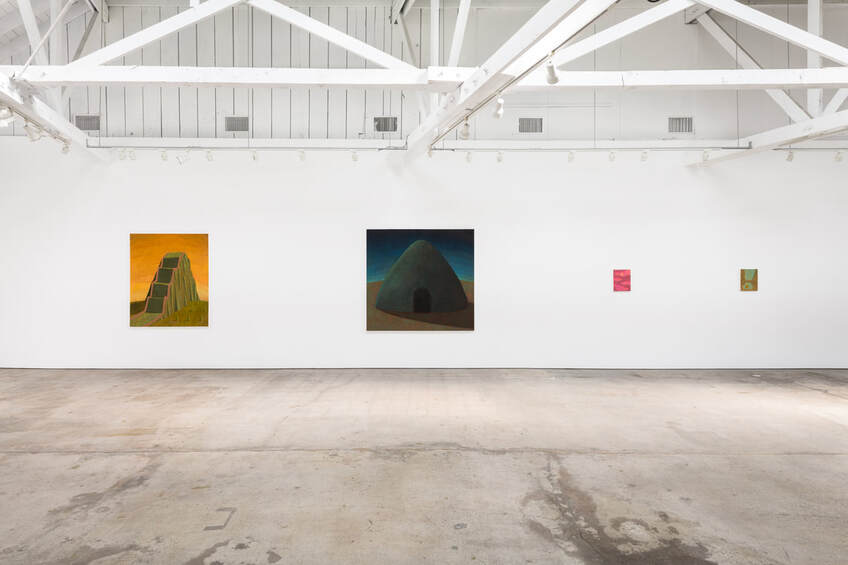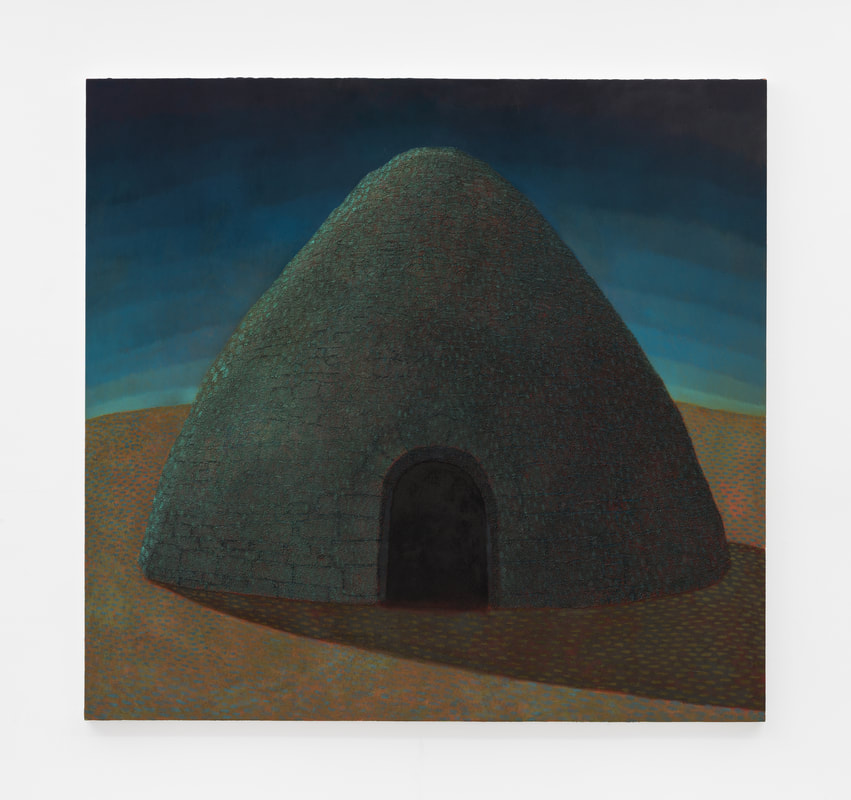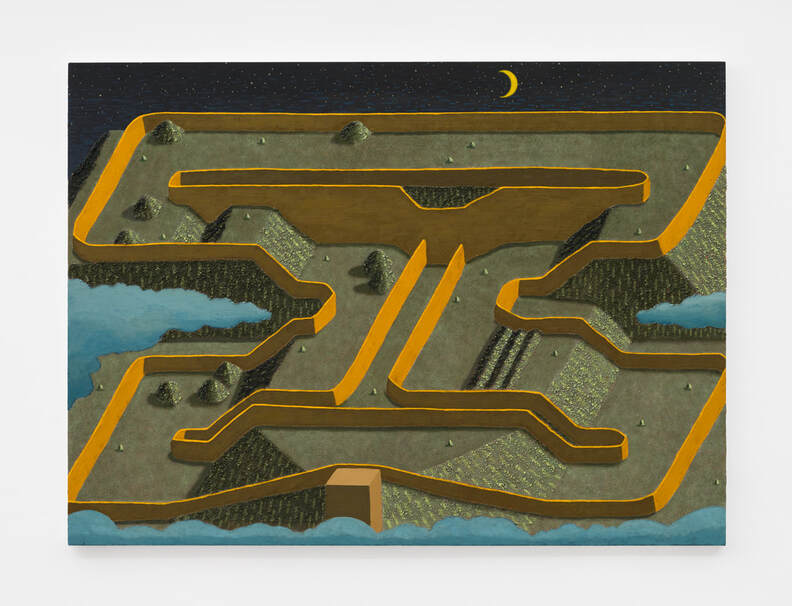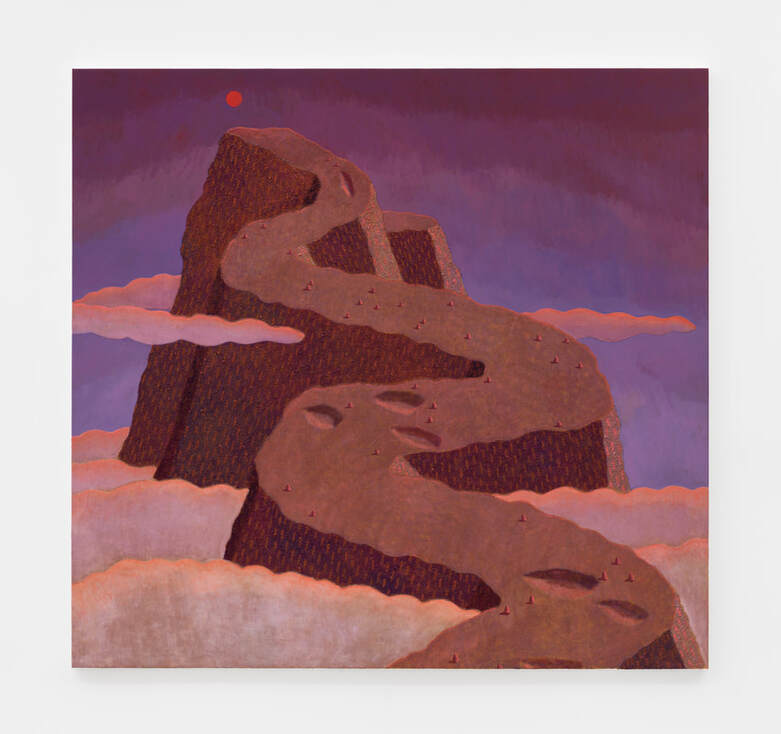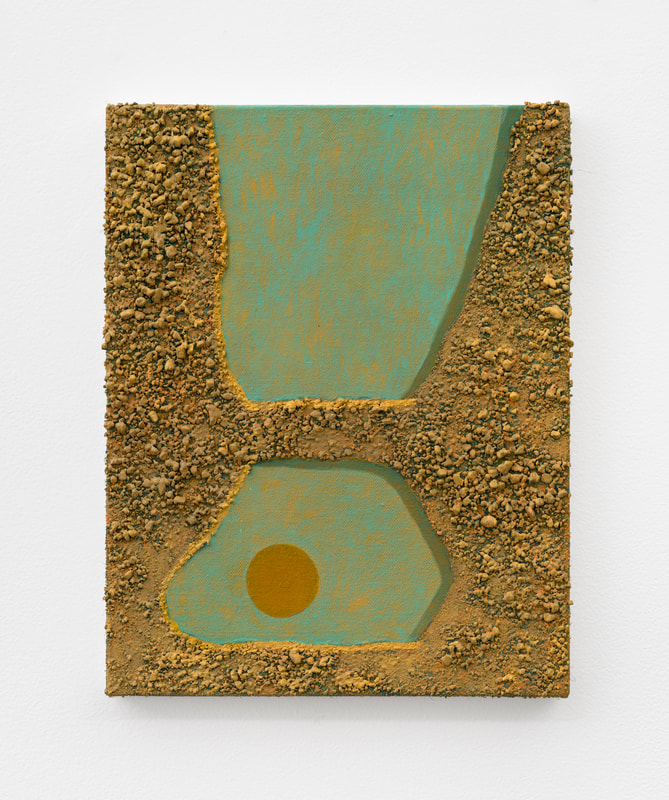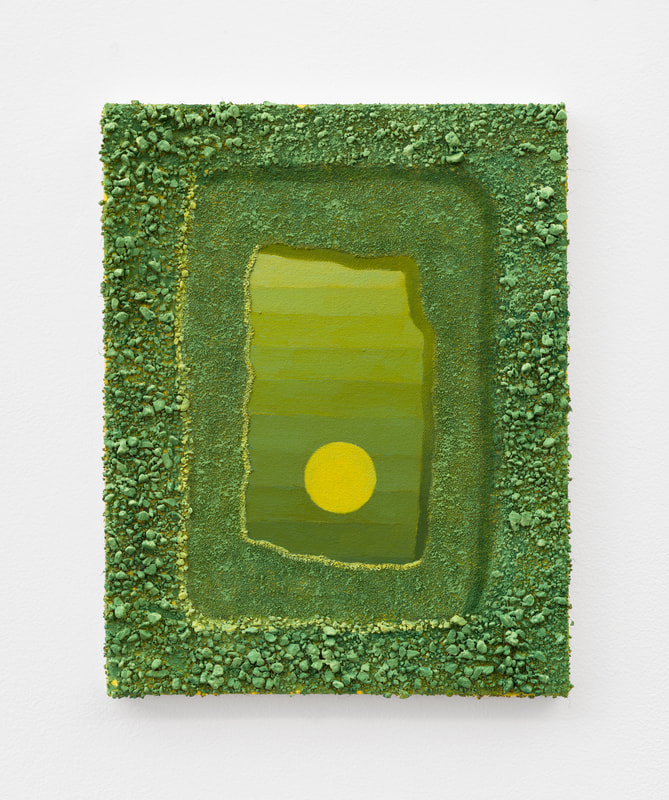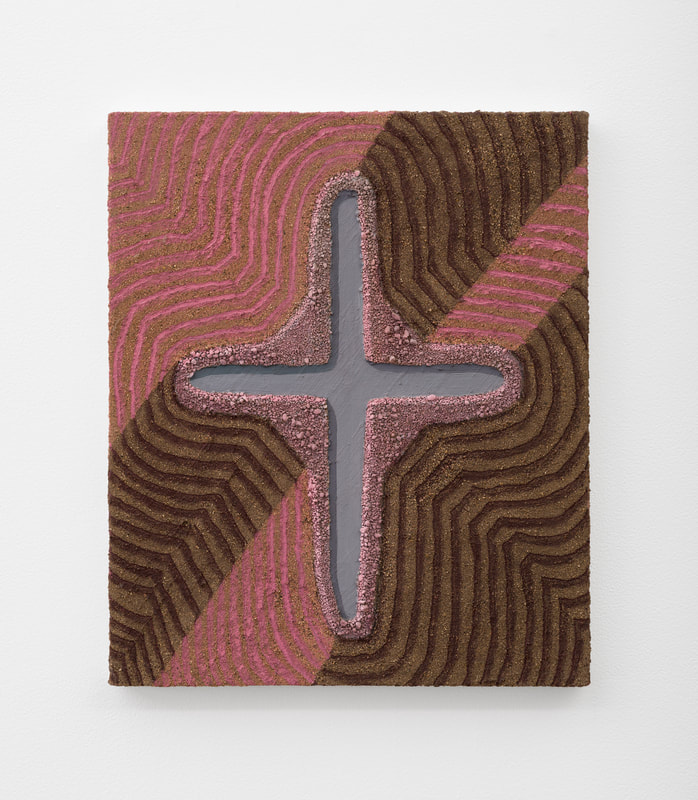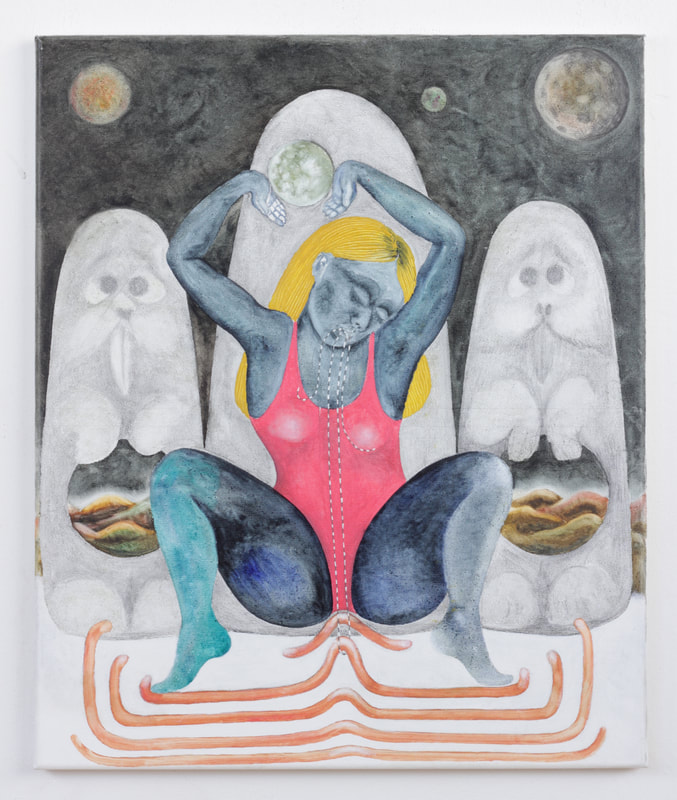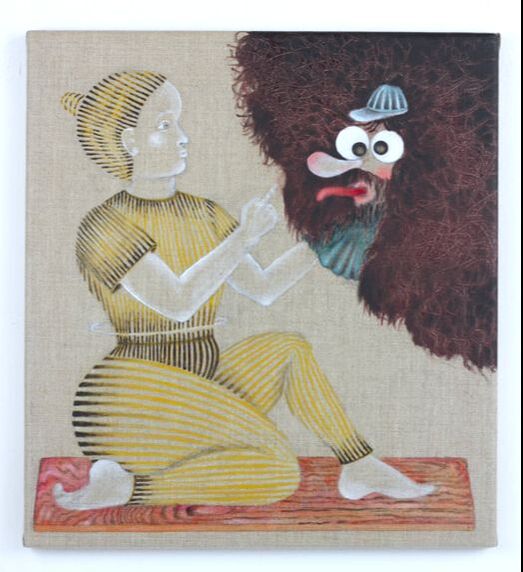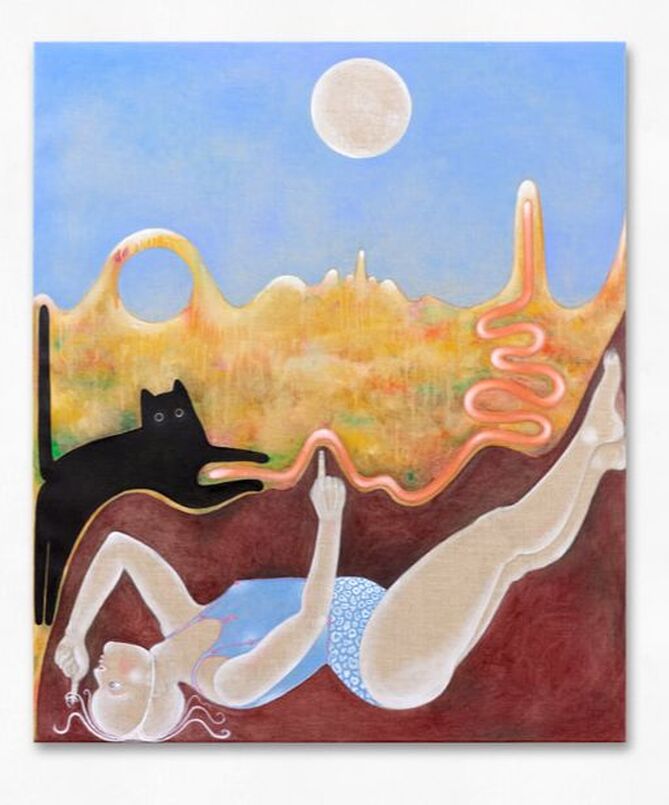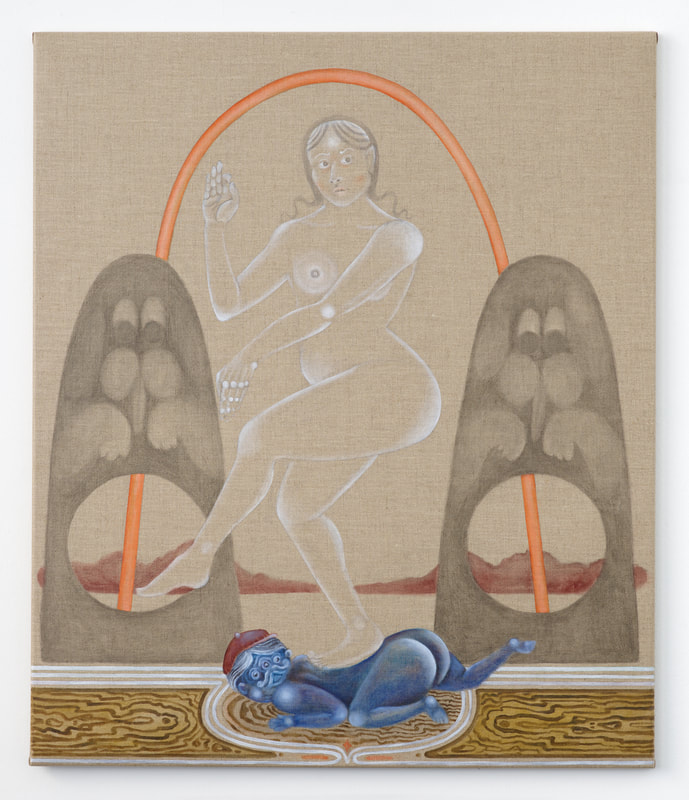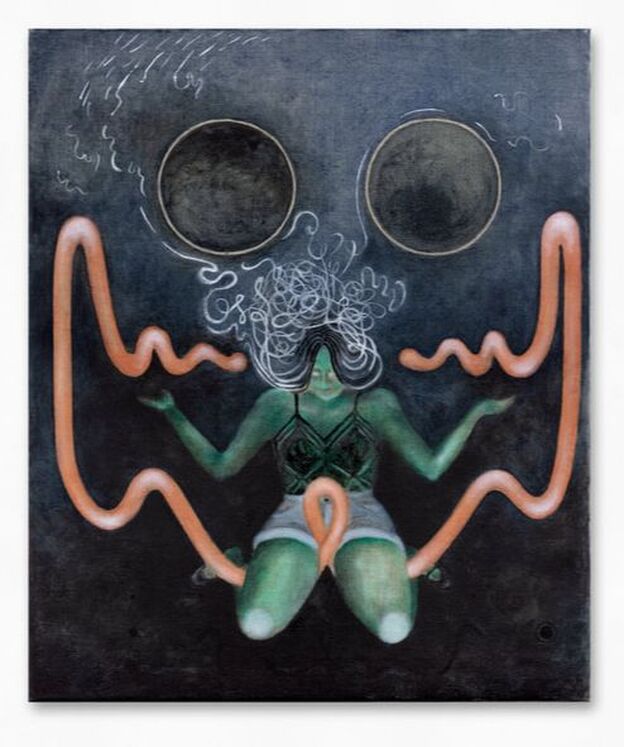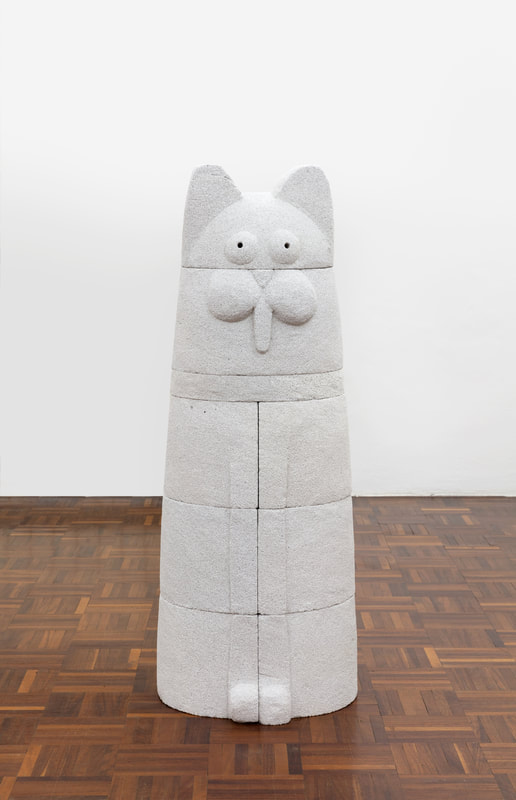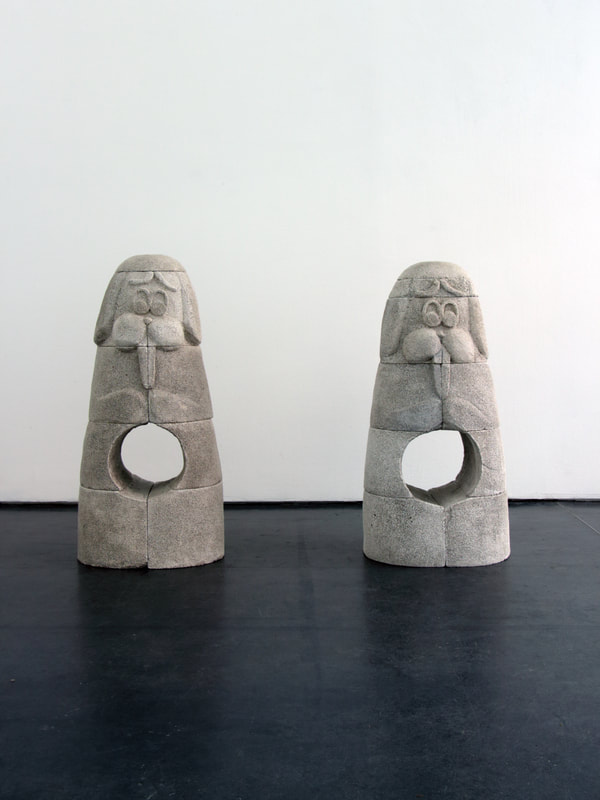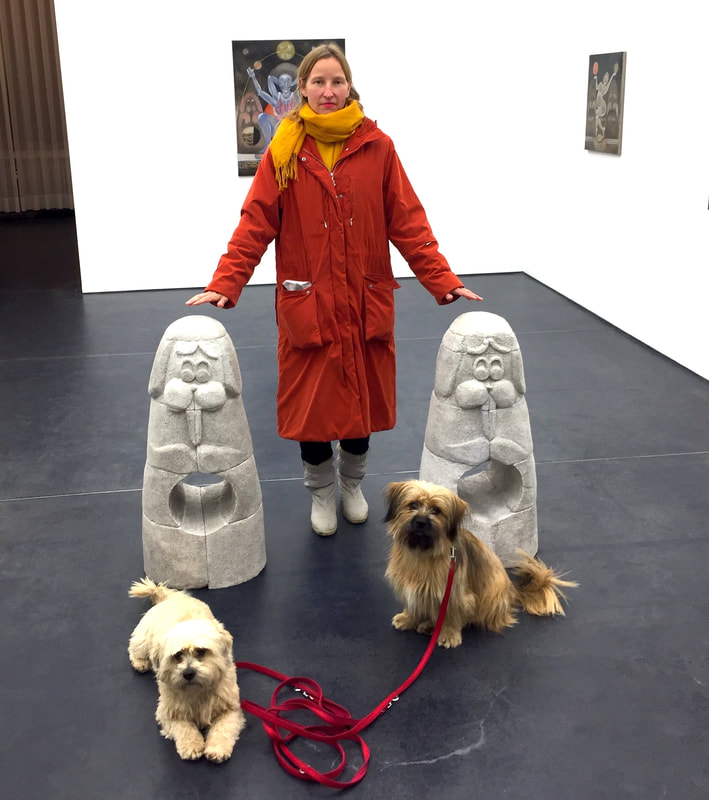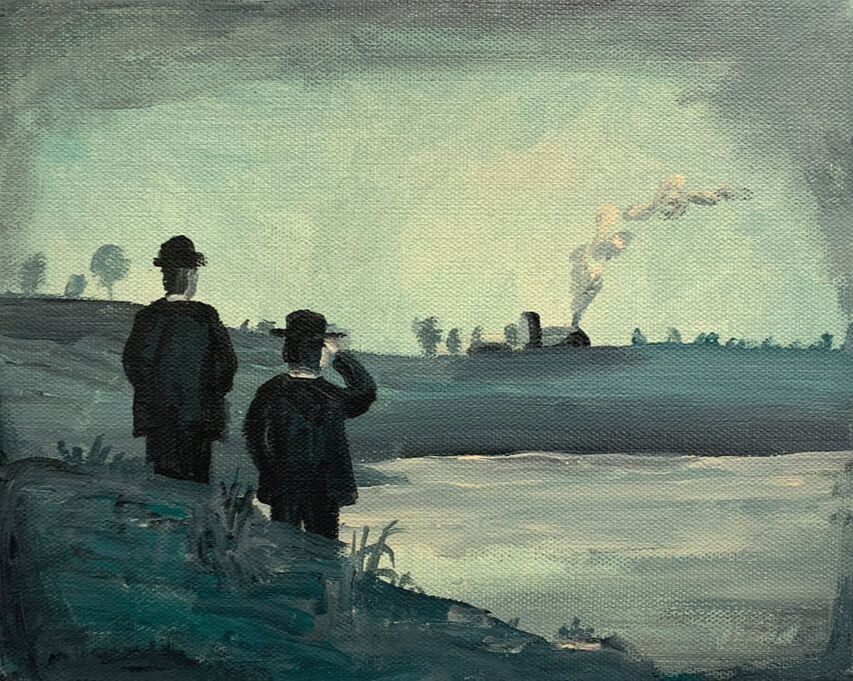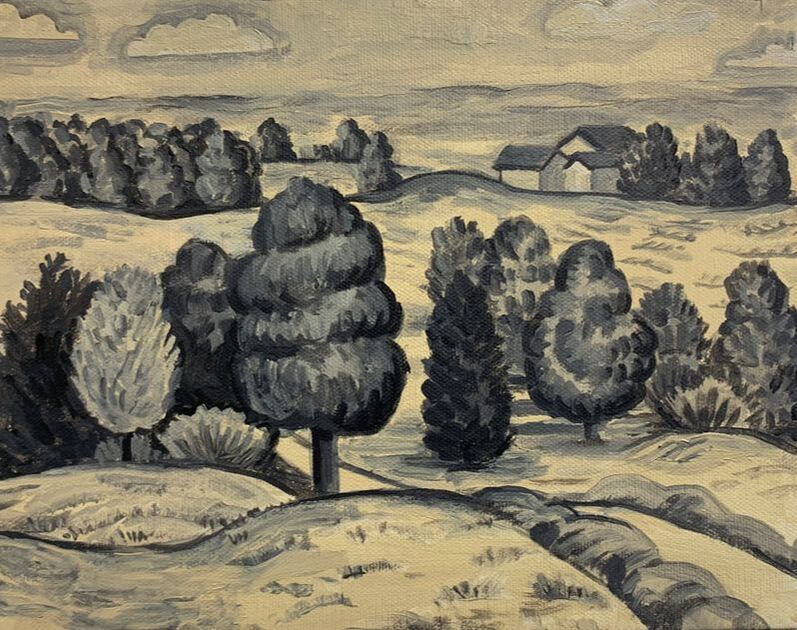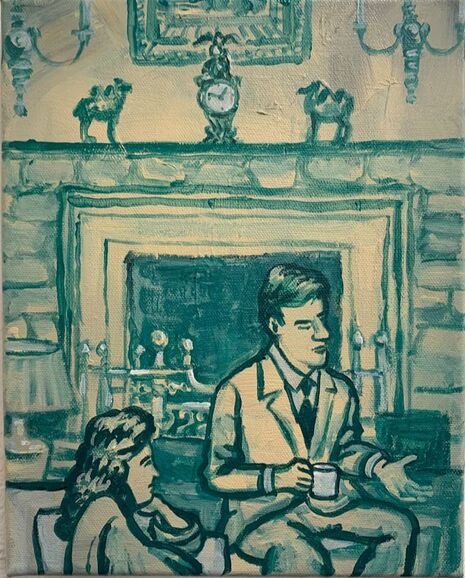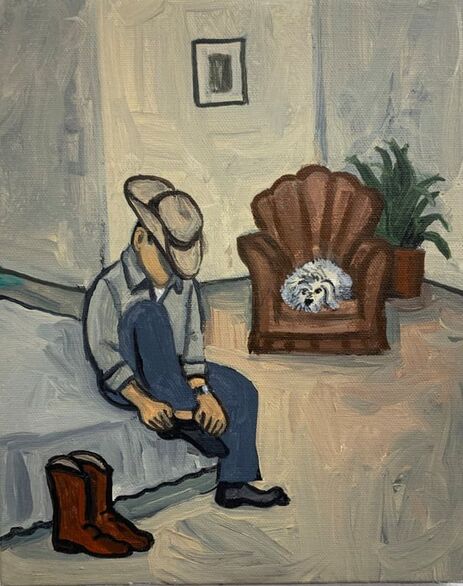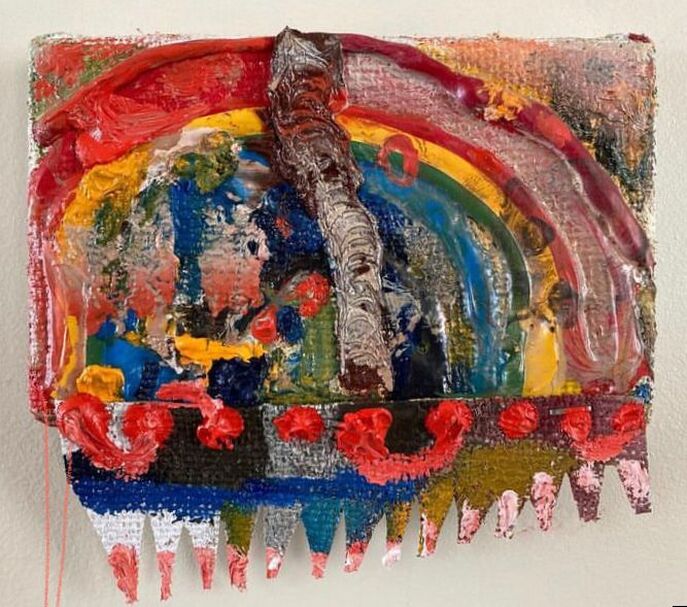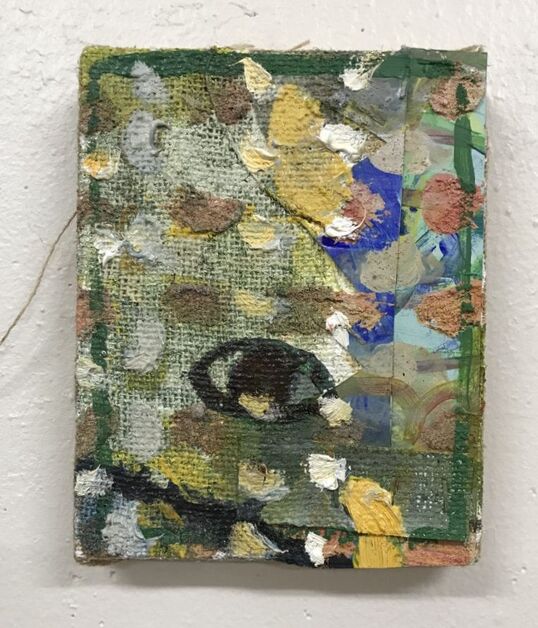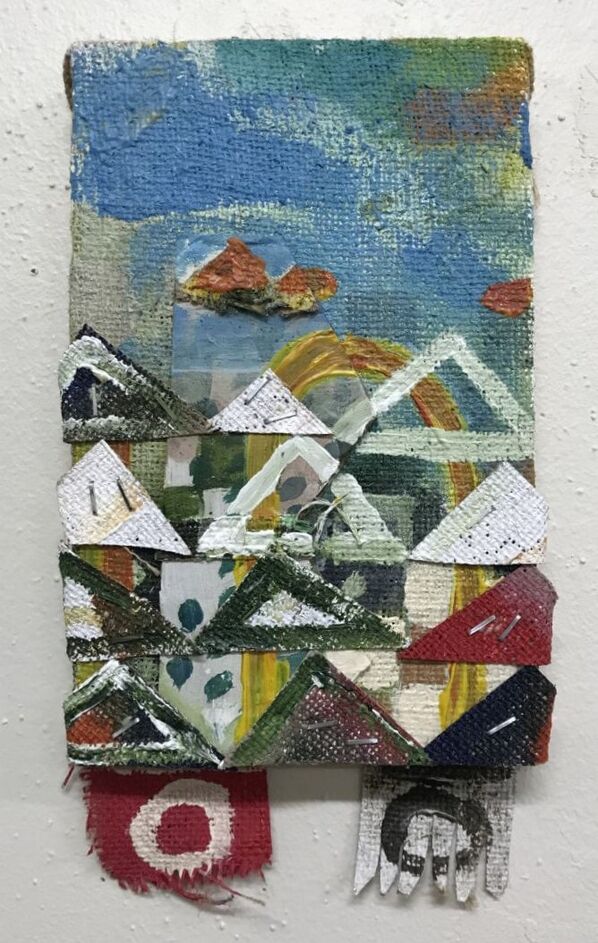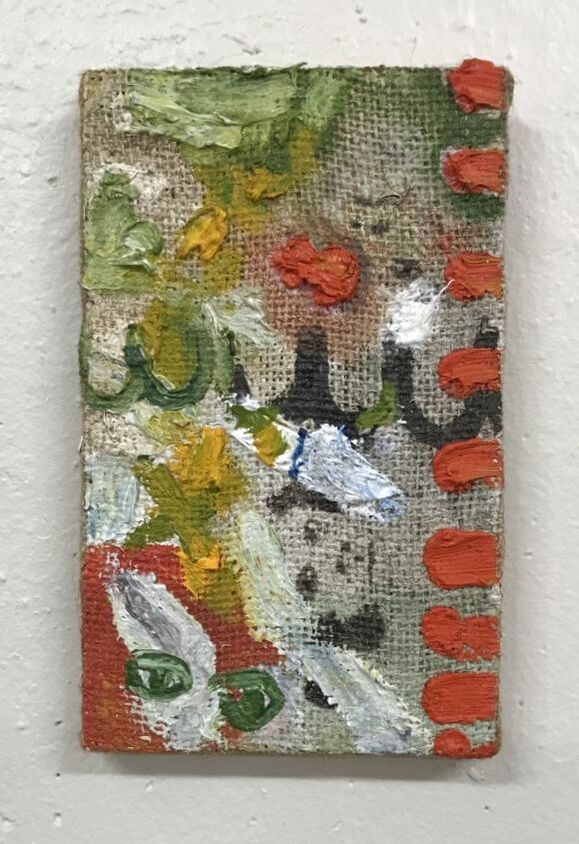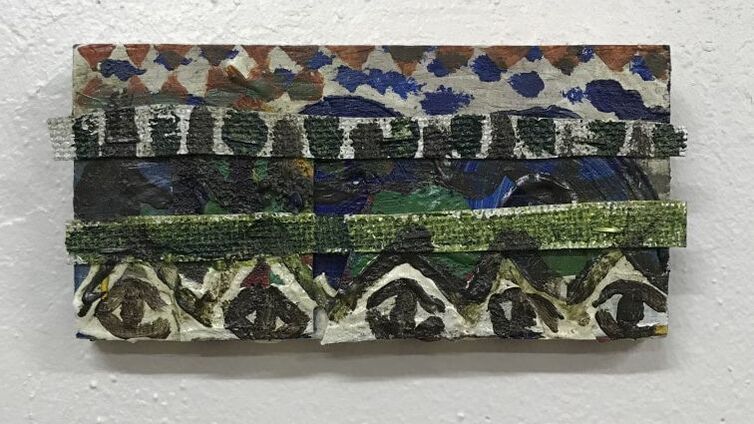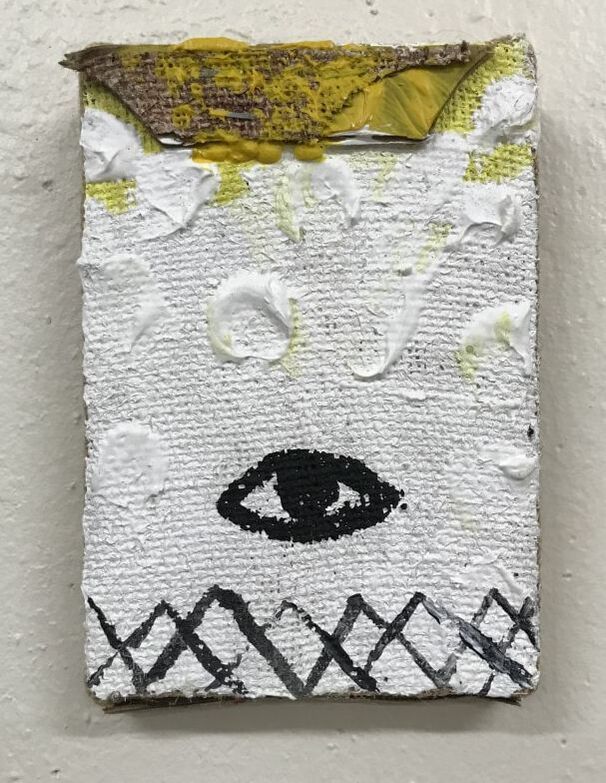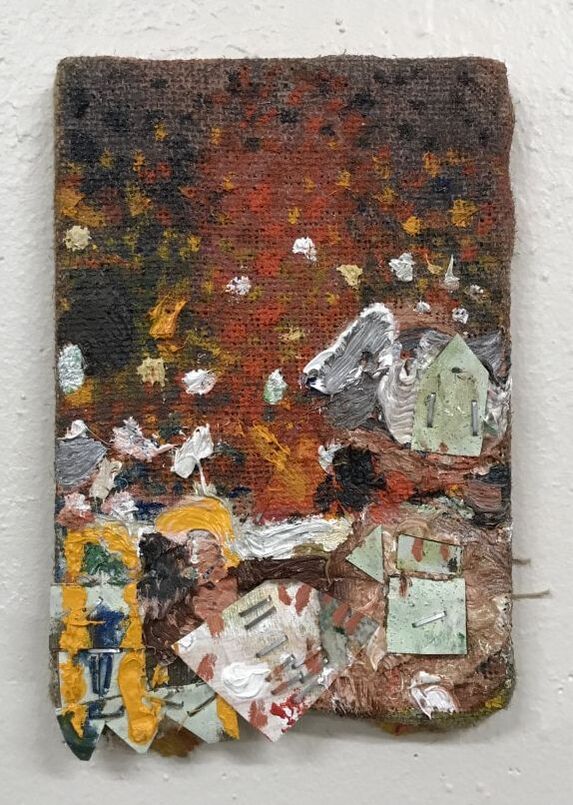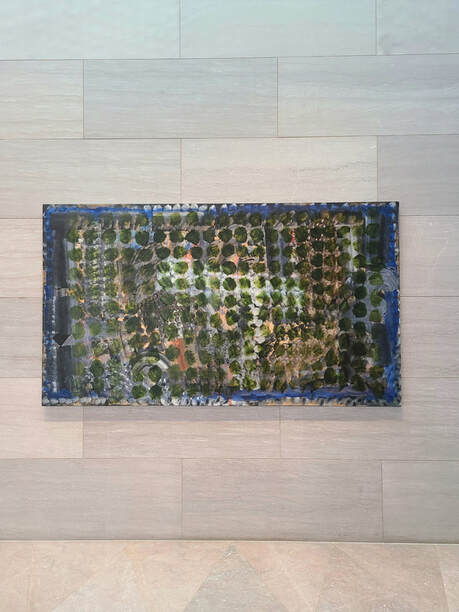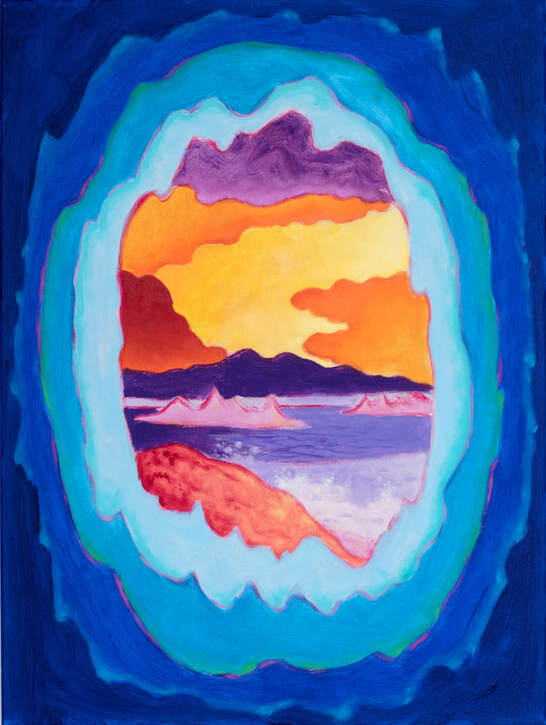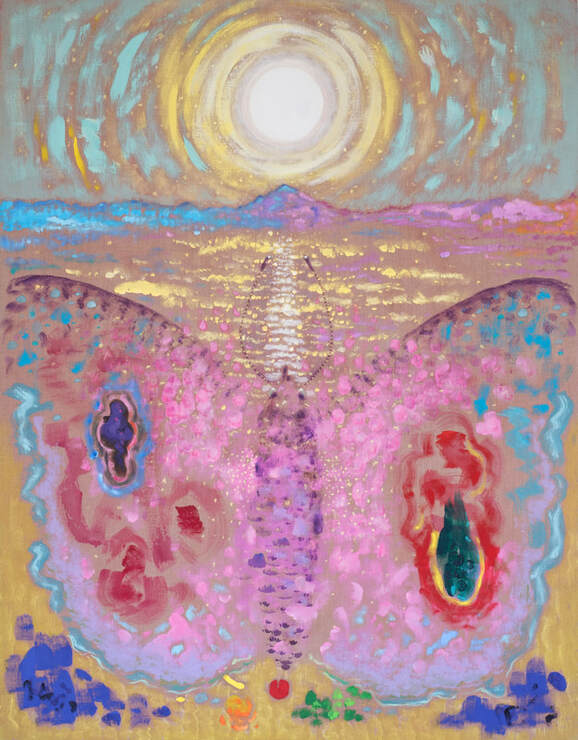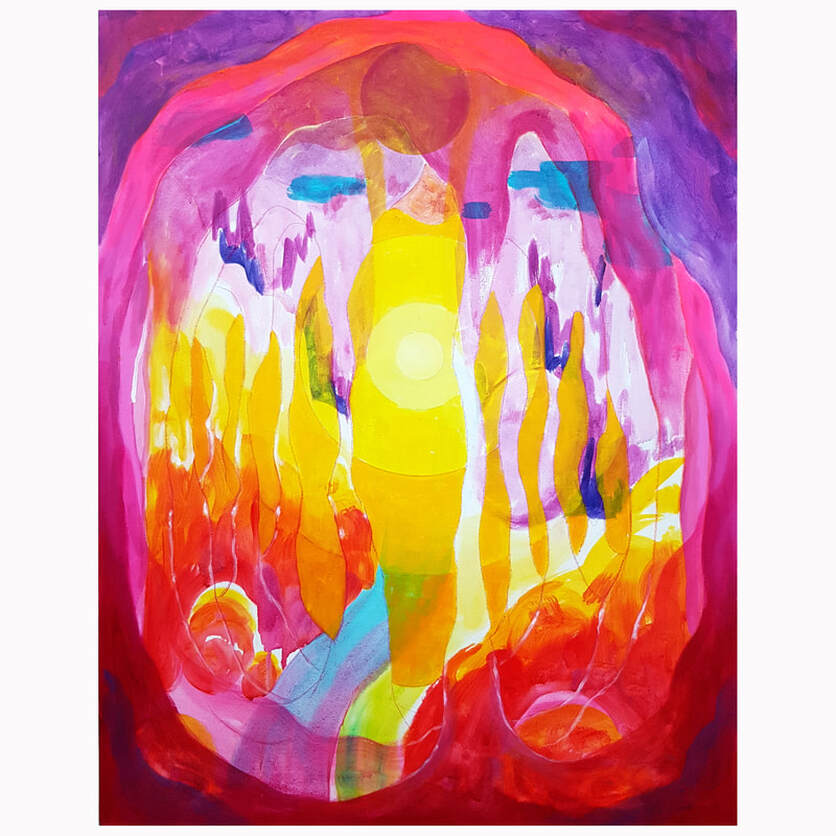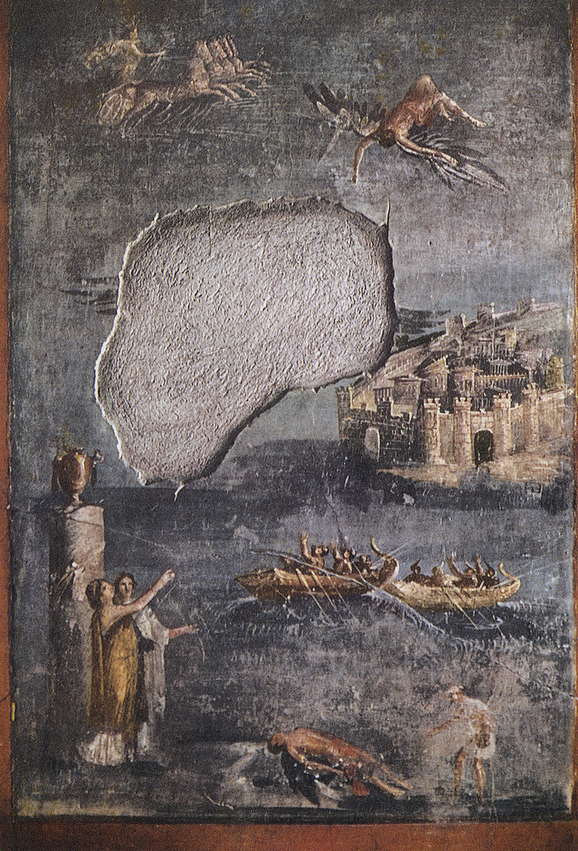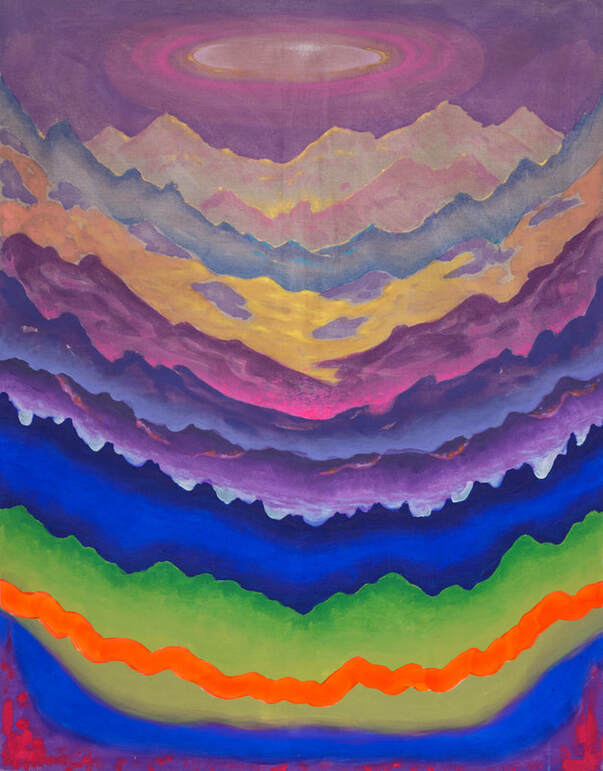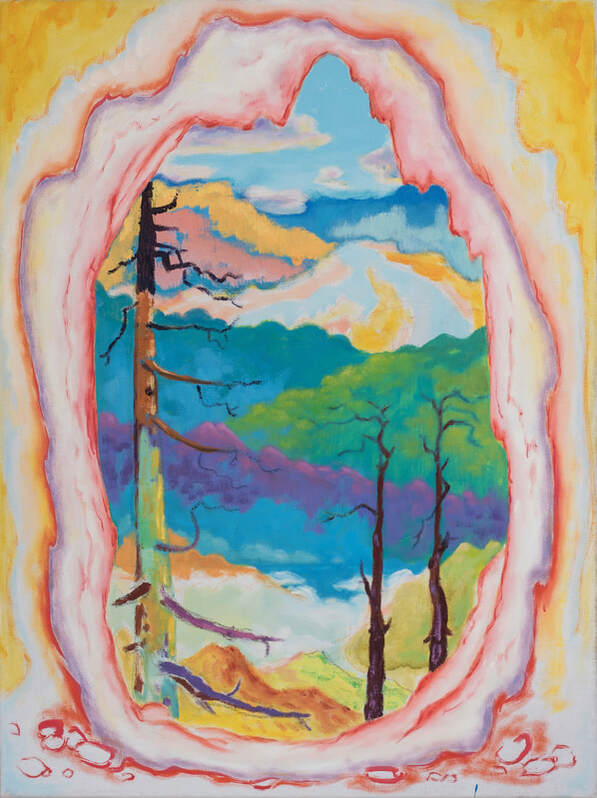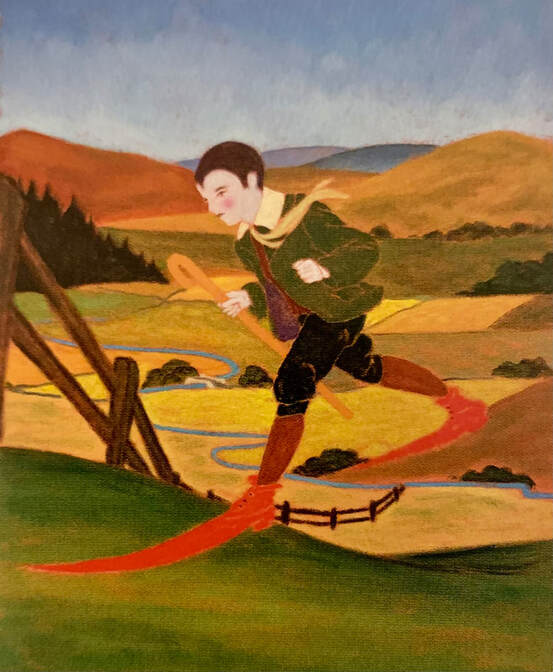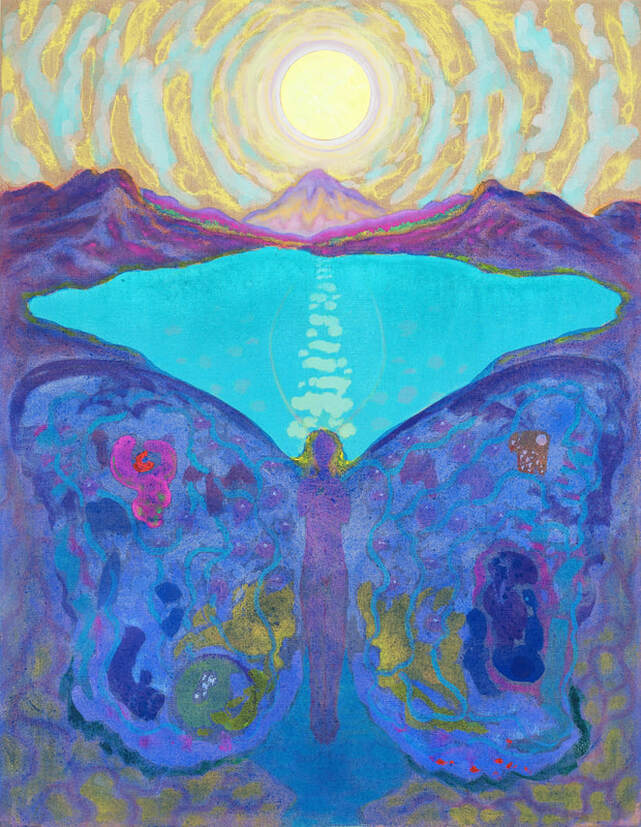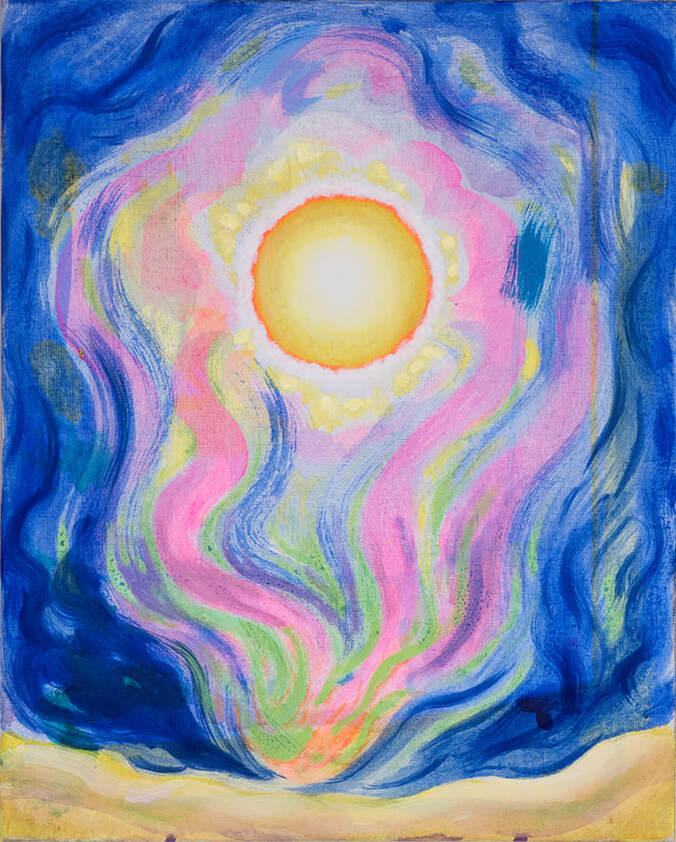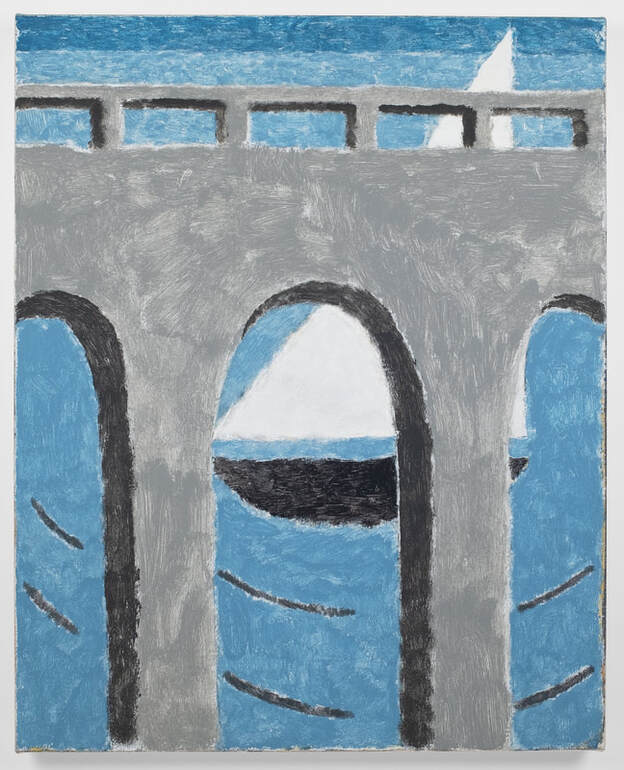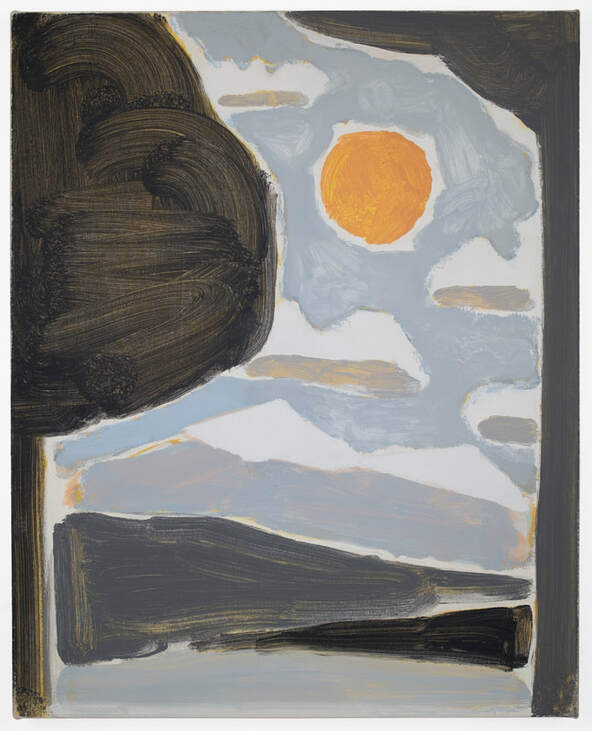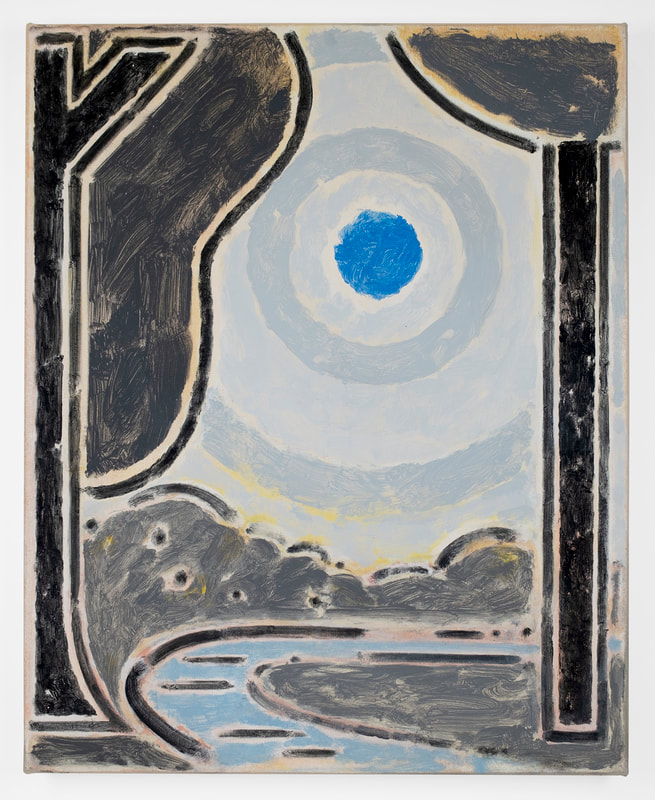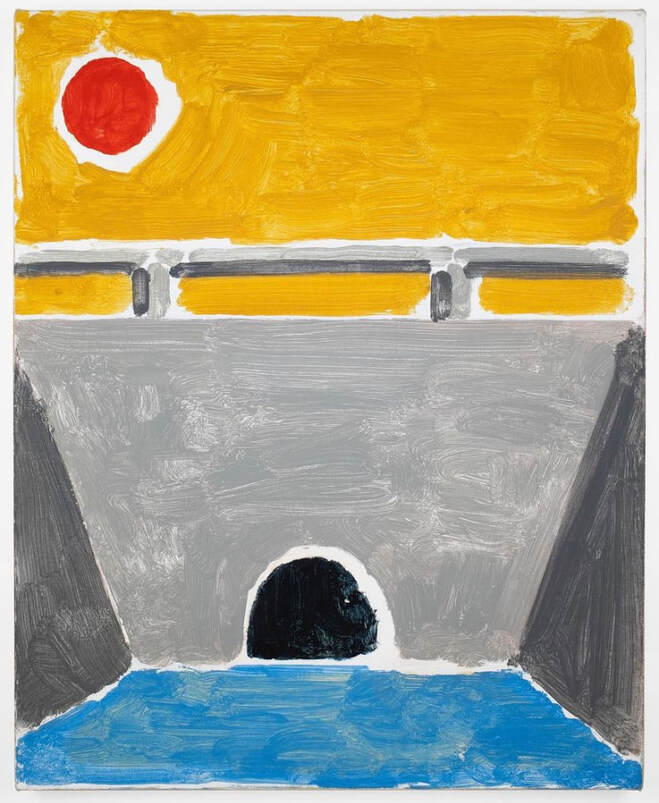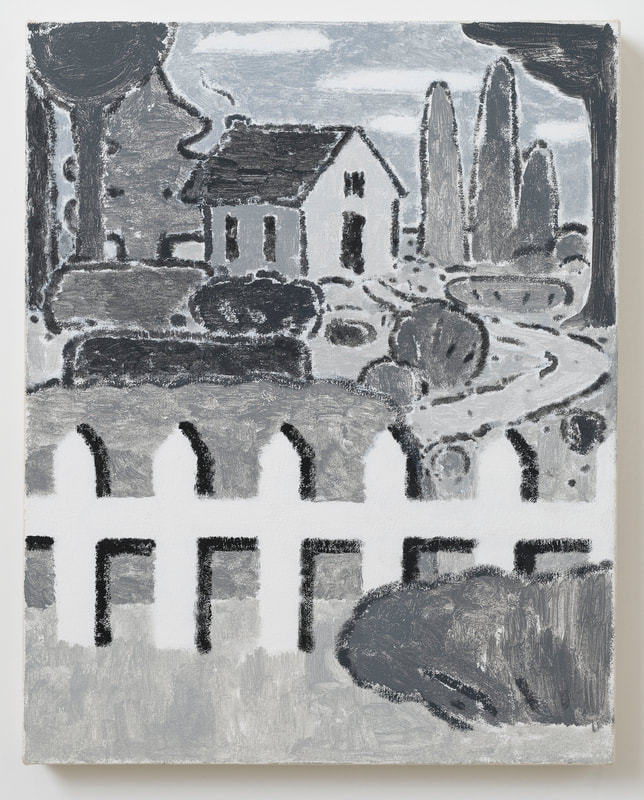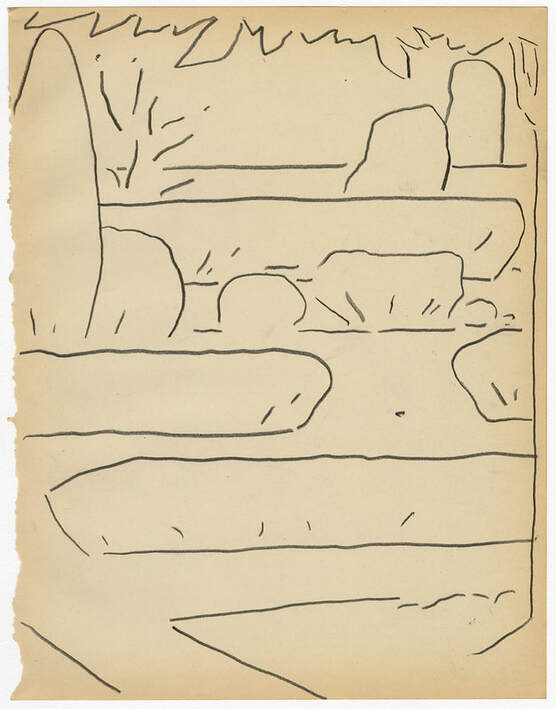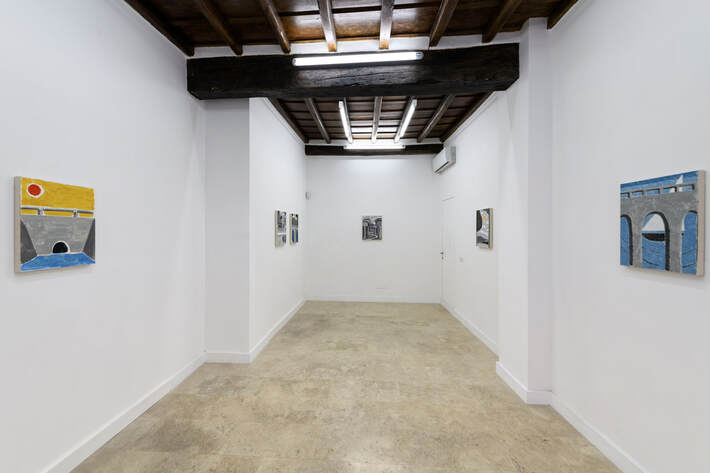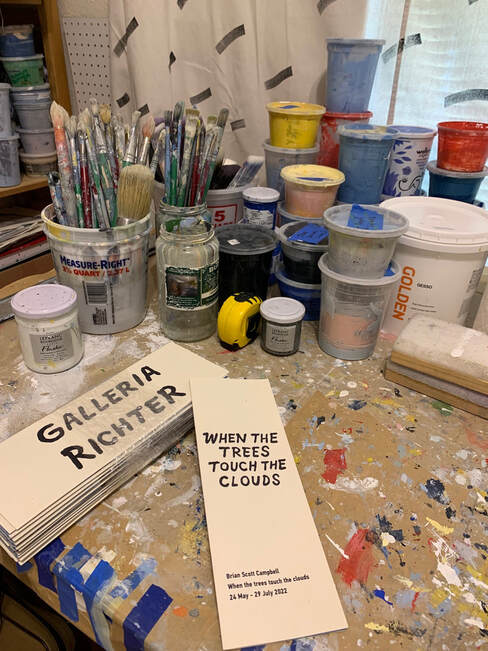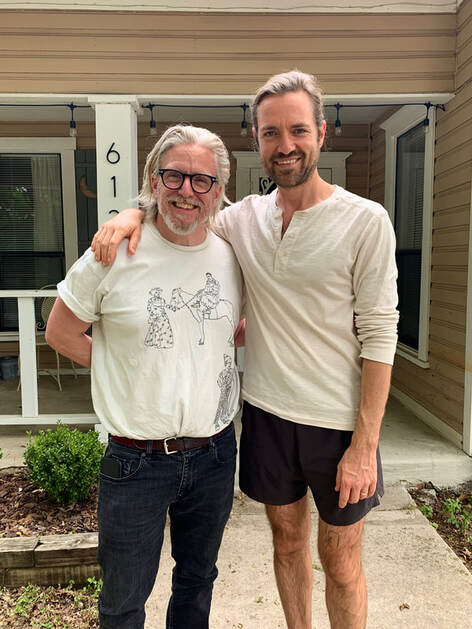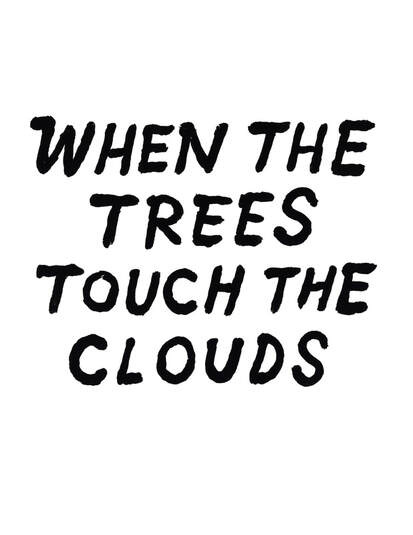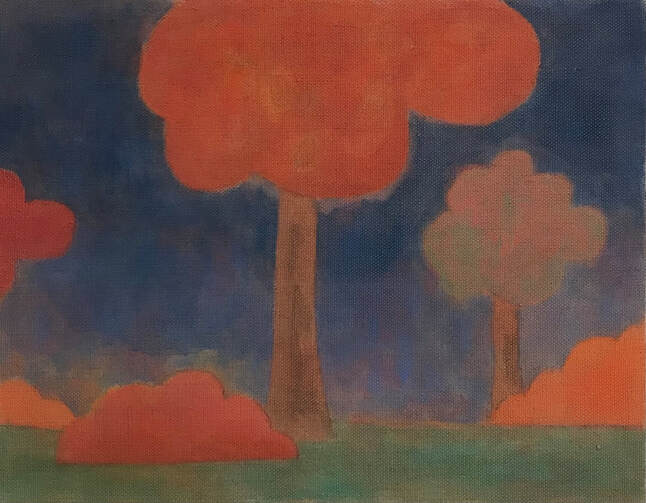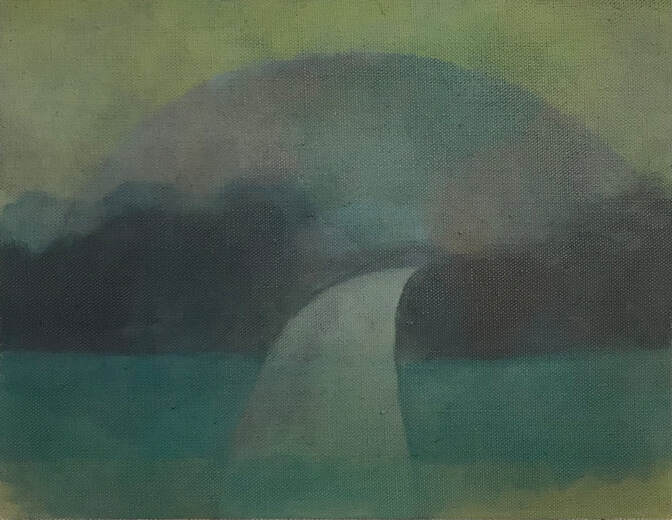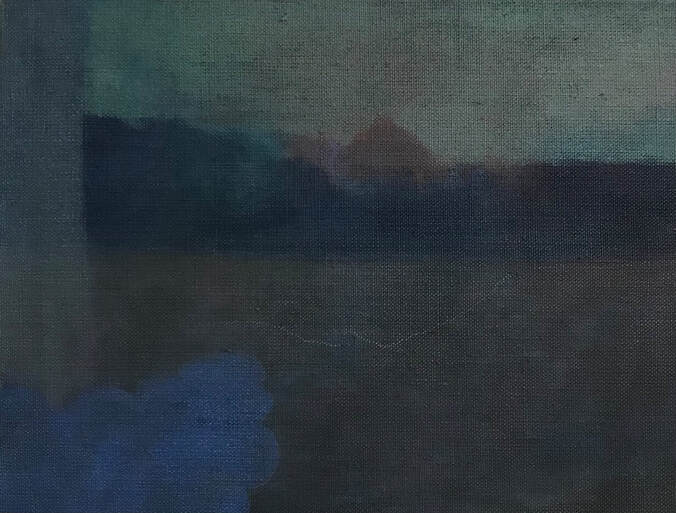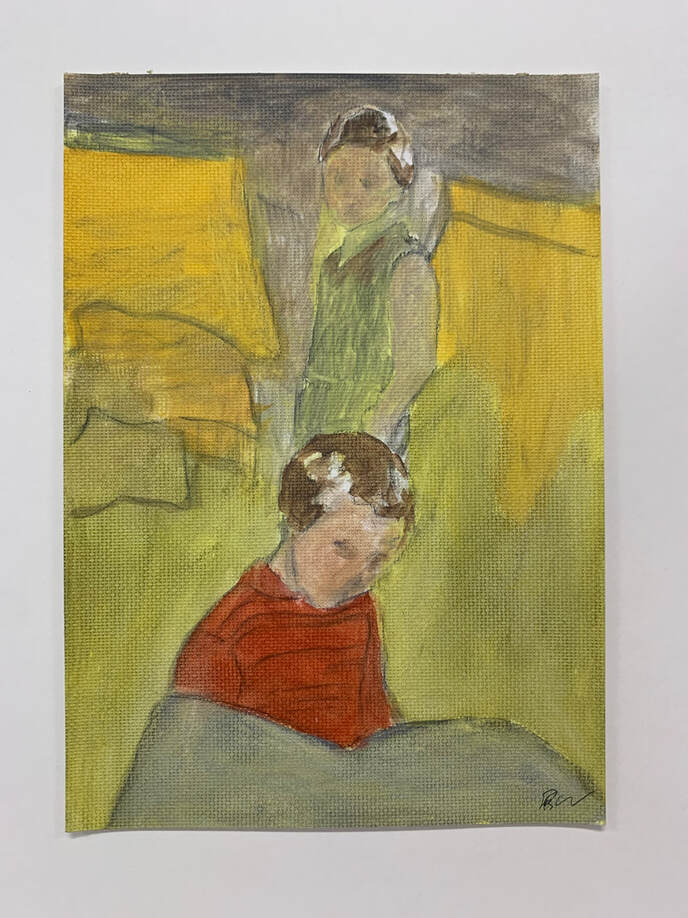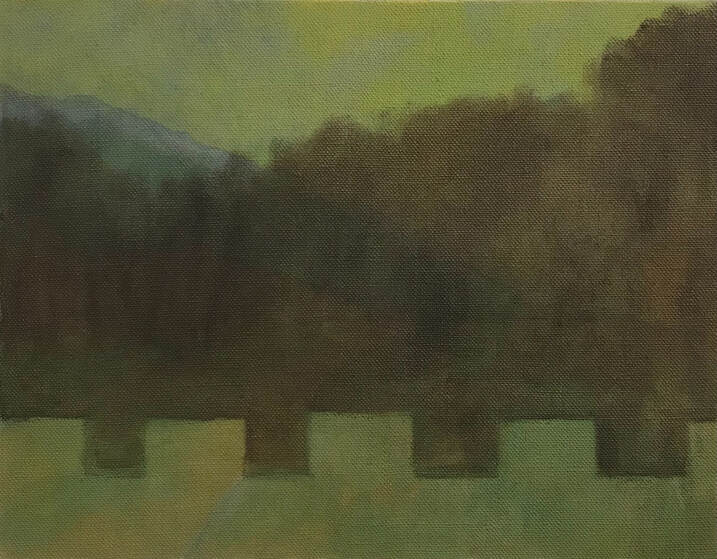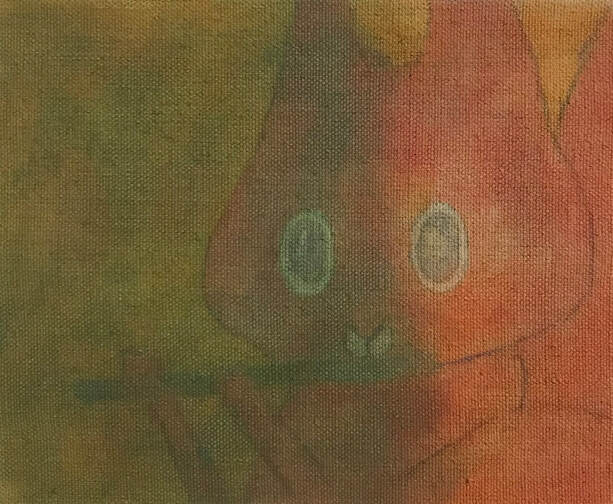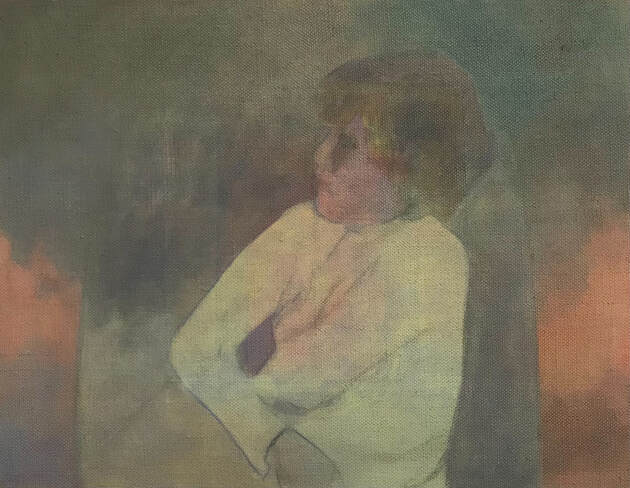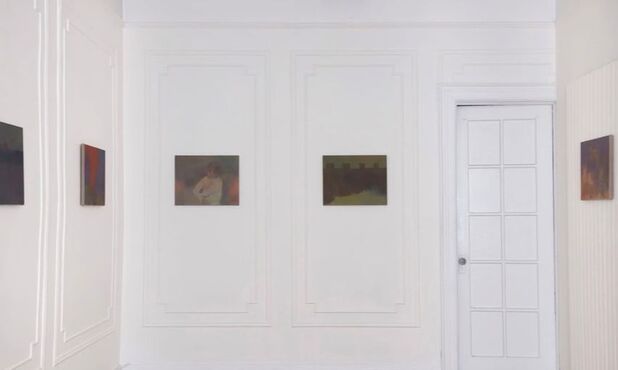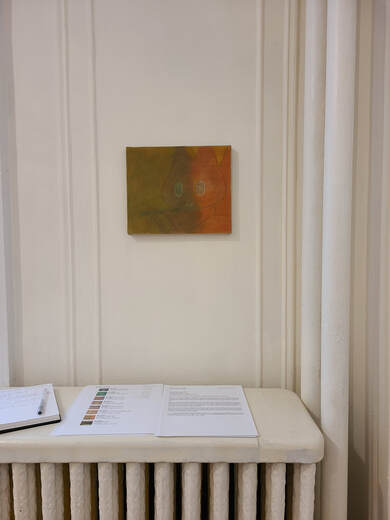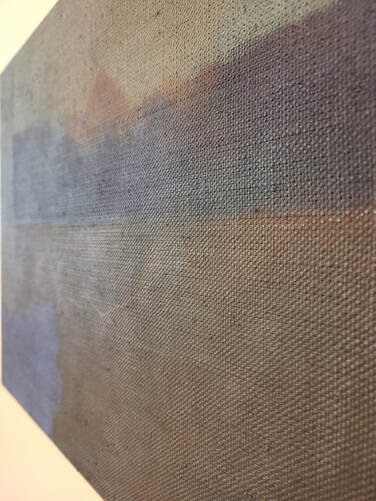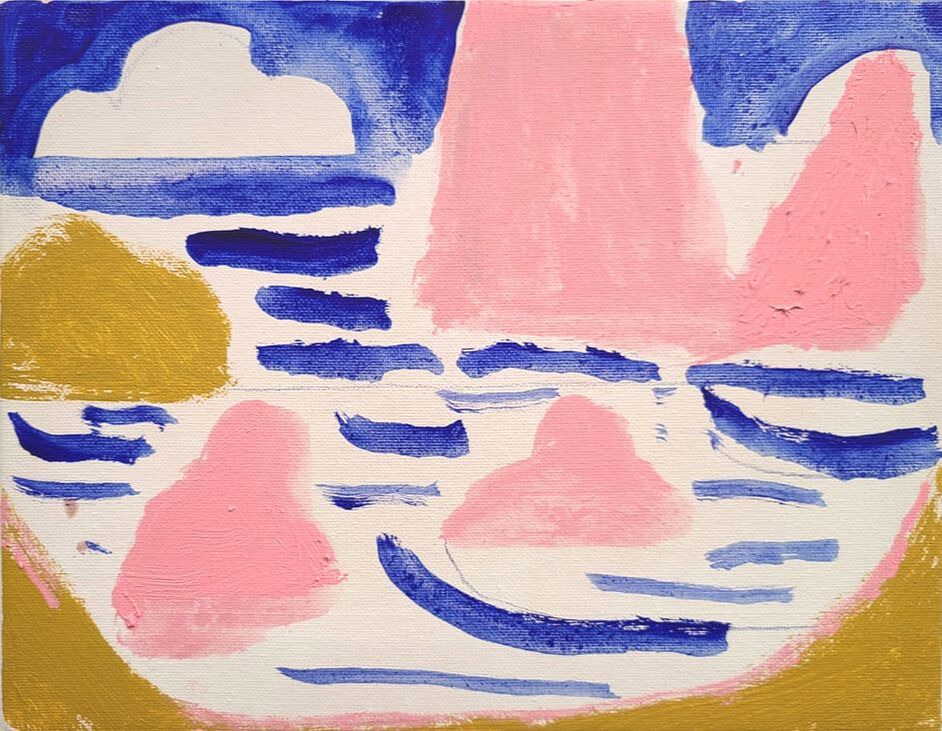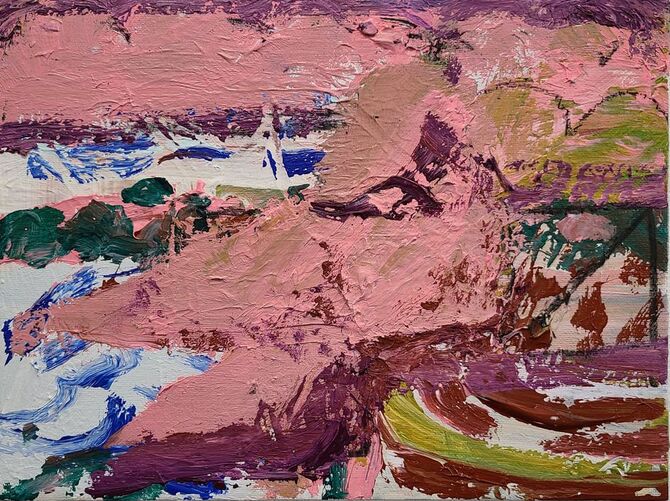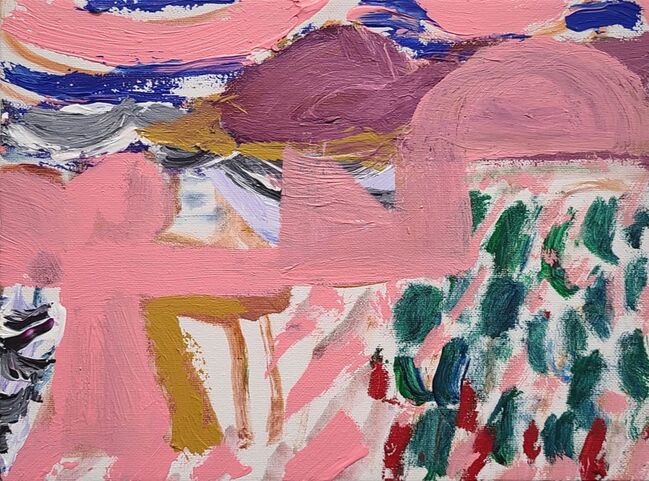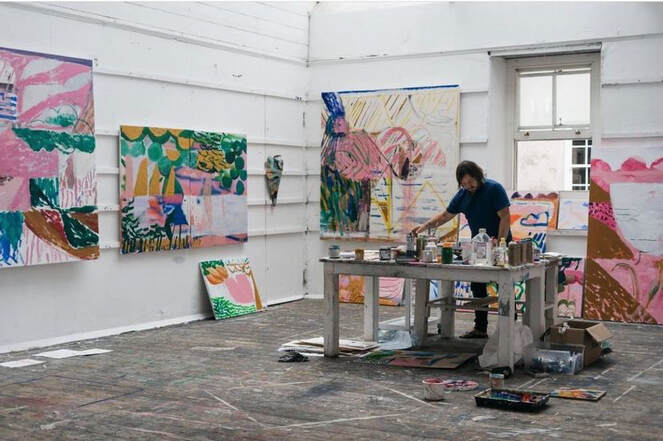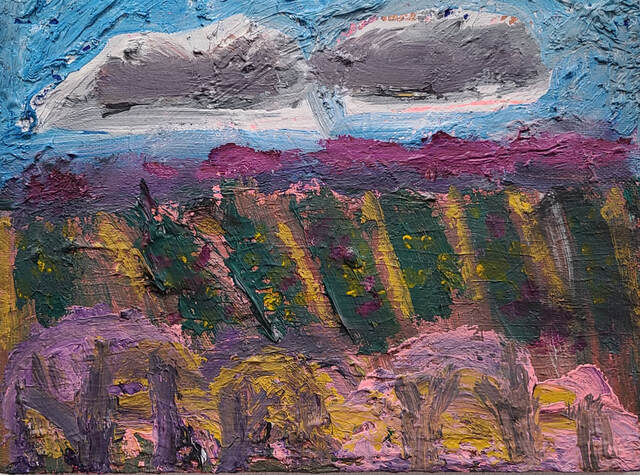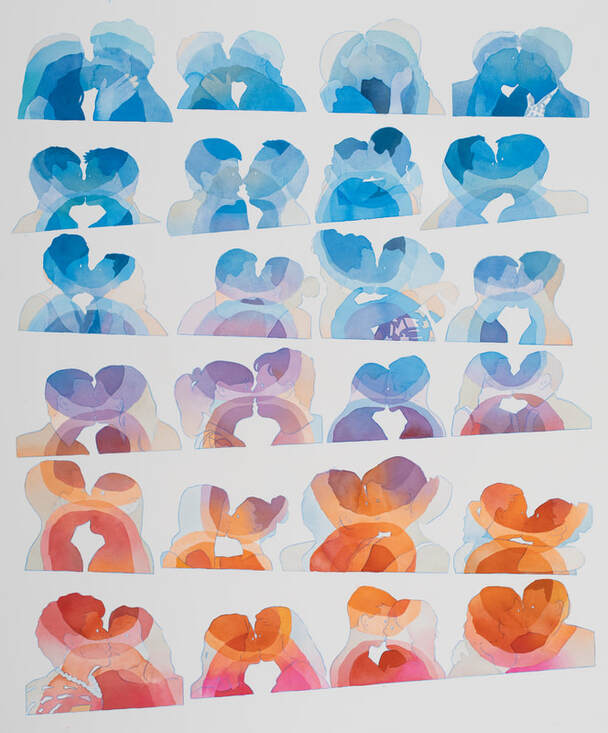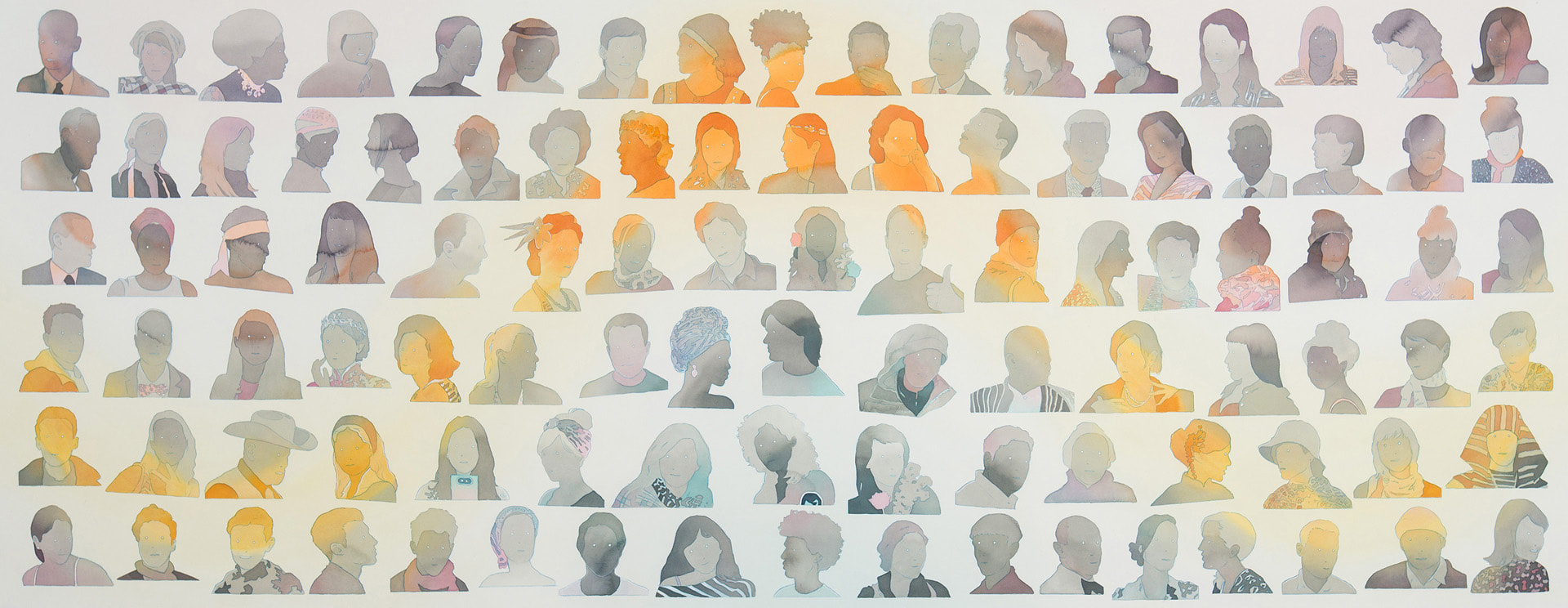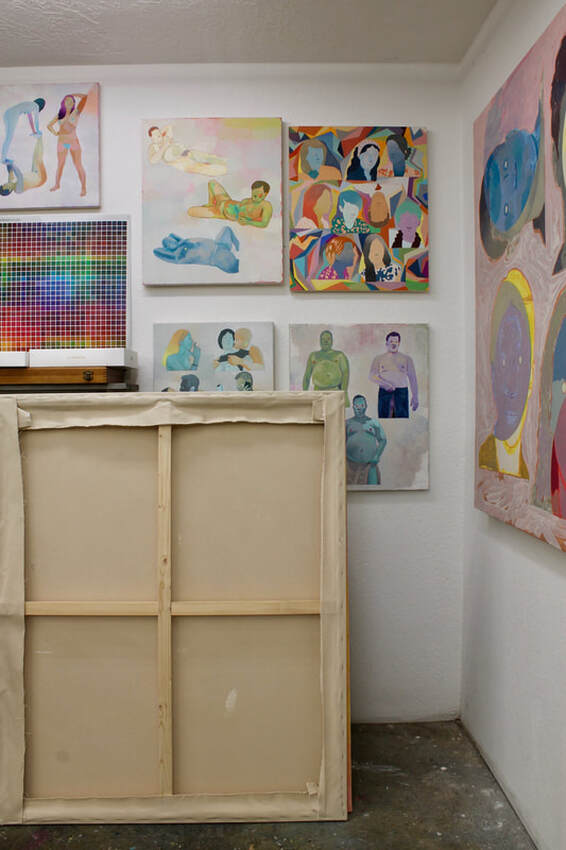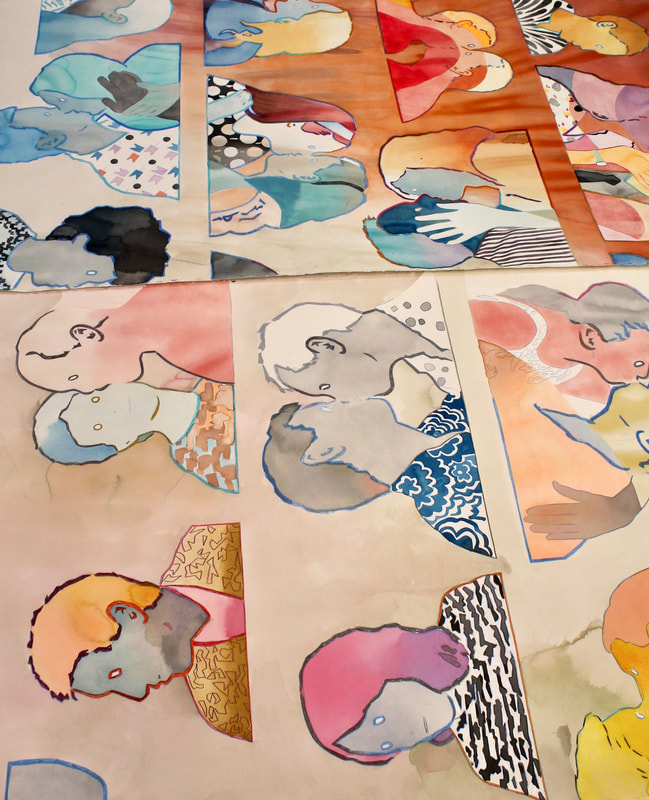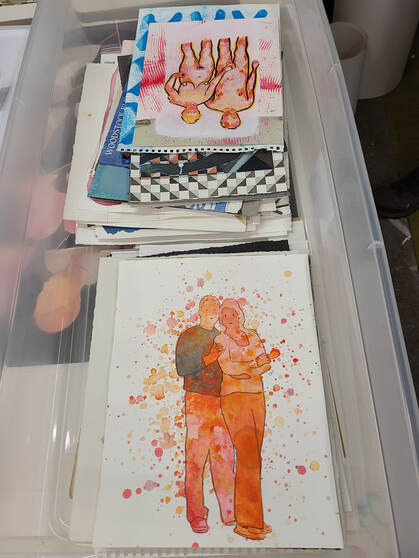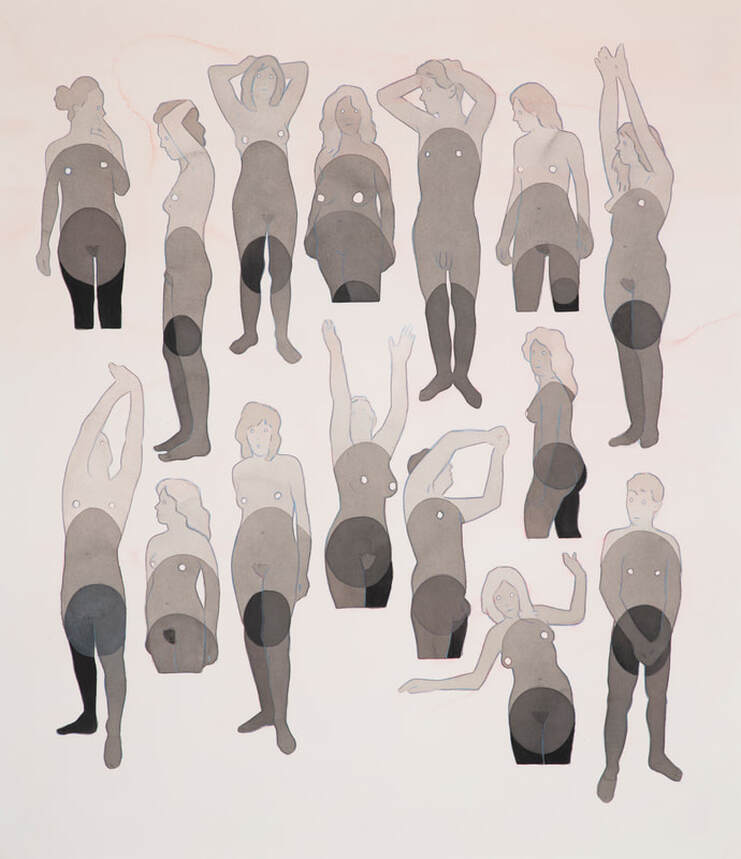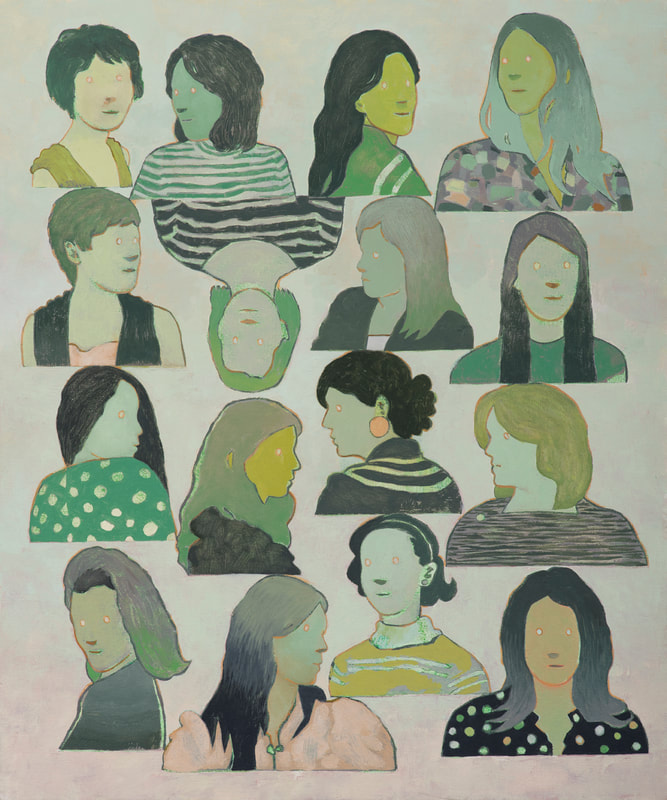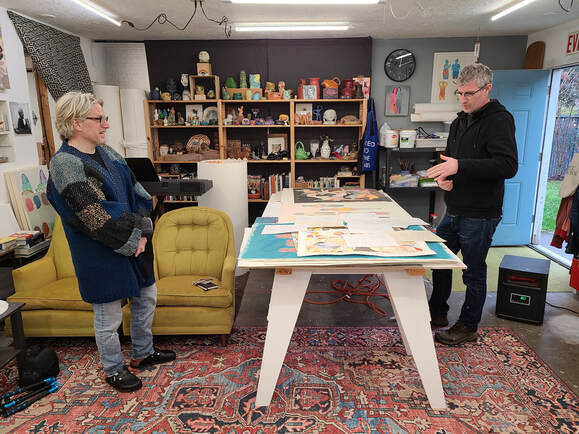|
7/23/2024 0 Comments #18: 07/23/2024On the Work of Gosia Machon by Benjamin Terrell Dove 2014/2022, edition of 10 (signed and numbered), 40cm x 50cm (15 3/4" x 19 1/2") The train whistle blew and a herd of horses was driven in two different directions. Most art is born from the struggle of freeing itself from that of which it is not. And during that exchange the artist is temporarily free to wander beyond the confinement of her or his mortality. Sometimes we too begin divided, as both illusion and apparition, haunting mansions of our own making. Artist Gosia Machon, corresponding about this show, explained that in German "geist" meant ghost but also can mean mind. And for her the mind isn't individual and anchored, it is part of a collective air-body that includes our entire atmosphere and is inseparable from what circulates and sustains us our entire life. Perhaps Machon's ghost is also "us" prior to our preferences, and Silent Ghost is the quiet mind that precedes a false notion of separateness and superiority. Let us then not struggle to become, but to emerge from the fiction of fantasy and let us be preened by our ghosts like a fowl might fix its feathers. Visor 2022, ink and charcoal on paper, 40cm x 30cm (15 3/4" x 12") "A man in passing glanced in a window, and all he'd ever seen was there. In the next street, a boy walked along, counting the cobblestones: One, one, one, one, one." - Cole Swensen Life is often as ungraspable as pipe smoke, as illusory as the surface of a pond mistaken for what it reflects. At best we perpetually "polish the mirror" and work with a handful of things that are fully understandable, arranging them in new and harmonious ways like the reappearing vessels of a Giorgio Morandi still life. For poet Cole Swensen, Goest (the title of the book of the above passage) means "to emerge" and to brighten from source. This could also be a reimagining or inversion of ghost. "The shapes would live themselves to life," writes Swensen, as if also to say, energy without shape can will itself into light. In another book, this one of essays, Swennen suggests that creative fiction exists fluidly between the real world and the boundaries of its fabrication. She quotes the Paul Hoover poem, Childhood and Its Double: "Everything's more real, once it finds its mirror. The grey lake and its grey sky." Unborn 2018, edition of 10 (signed and numbered), 45cm x 55cm (17 3/4" x 21 1/2") By far we are the most beautiful, victorious when we reach the shallow valleys. We love it in the gray clouds, so much so that the condensation makes the wings almost too heavy. We are by far the most beautiful. Now, having arrived in the damp valleys, the sky hangs lower. We love flying in gray clouds, our wings almost too heavy from the condensation. - (original text by) Anke Feuchtenberger Above are two interpretations from Google Translate of a text about Gosia Machon's work. We too evolve and devolve in virtual spaces and poetry is often the persistent ineffable ether of the places we feel the most certain, words gasping for further breadth. Translation at its most sincere is ghostly refraction, a stratus blanketing between art and its intention, like a grayed prismed playground for spirited potential. We could also add- truth is debatable as its translation, truth is deflate-able at the source of its friction, truth is as unstable as its diction. Perhaps the most successful two-dimensional art, like Machon's, acts as a reflective surface between us and all of the subtle yet staggering indivisible beauty that lovingly shimmers around us. Ghostly are the two types of silence: restrictive silence born from limitation when the unguided mind dampens potentiality, or the kind that comes after direct experience but before articulation. It is the second variety that induces awe. Gods and Goats 2024, edition 10 (signed and dated), 40cm x 50cm (15 3/4" x 19 1/2") The passage is taken; the maze builds. Side riffs curl off. Direction is difficult to keep. Space is behaving strangely - and so too is time. Time moves differently here in the underland. It thickens, pools, flows, rushes, slows. Down between the roots to a passage of stone that deepens steeply into the earth. Colour depletes to greys, brown, black. Cold air pushes past. Above is solid rock, utter matter. The surface is scarcely thinkable. Robert Macfarlane, Underland In a sea of deep sepia and clinker brick brown shapes shun shadow to make masks of what were once recognizable faces. Machon's masks are more like the inside of masks than the surfaces of a false face, as if the artwork itself was our veil to see beyond this era of casual viewing to deeper inquiry and participation. A mask in the round is a globe, the spherical weight of entirety or perhaps the full circle of a cycle fulfilled. In silent Ghosts the circle is central- it is the moon that a passing bird divides, it is the head of a human and the oversized blooms of the branches above. Reappearing as dark orbs stacked and tethered to a single white orb, like interdependent and intimate engines of circumference. Machon's atmospheres are often like a tunnel or a conduit, paradise's boiler room perhaps, where creativity's most basic elements are transformed, offering a more insightful passage. Left: Mask 2014, ink on paper, 40cm x 30cm (15 3/4" x 12") Right: Heritage 2022, ink on paper, 40cm x 30cm (15 3/4" x 12") Many images in Silent Ghosts are birds and what is a bird beyond its song but a meditation on flight and how a dialogue with the wind balances two opposed worlds. The bird's domain is the sky, yet they rule it only temporarily and although a bird nests on the ground, they are not entirely of the earth either. Similarly displaced, we spend the first half of life grounded by a skewed sense of worldly ownership, yet later life is a realization that nothing is ours beyond the way we occupy the unknowable. The bird then is an apt symbol for how the fragility of ascension exists interwoven with the weight of vulnerability. Perhaps an ephemeral truth of the Silent Ghost is that once we are able to identify with one thing completely, we are already in the process of becoming something else. I have read that what we see as reality is actually only a sliver of a full circle of experience that we inhabit, the rest being beyond our senses' ability to measure. We are ghosts, then, illumined by parts of ourselves we have yet to meet, we fade and are silently reborn, separating from that which we think we are not. Your Eyes 2022, edition of 10 (signed and numbered), 20cm x 28cm (8" x 11") The Donkey 2022, ink on paper, 20cm x 28cm (8" x 11") You can see more of Gosia Machon's work...
- on her website - on instagram: www.instagram.com/_gosiamachon_/?hl=en - on MePaintsMe - at Galerie Soon
0 Comments
2/27/2024 1 Comment #17: 03/01/24On the Work of Jonathan Ryan by Benjamin Terrell Installation view of Jonathan Ryan's Mirage at The Landing Gallery in Los Angeles. Today our most memorable discoveries often come while scrolling and the greatest epics are all streaming. Conquest is rightfully a dirty word; the earth has been googled now for thirty years and our new ruins are what's too large for the recycling bin and what's left behind in the average park block. Even so, unscaled mystery and enigmatic order still abound in places like the work of painter Jonathan Ryan and that's good news because we collectively thrive in new and unknown worlds when we feel historically chosen and challenged to crack a good code. The late art critic Peter Schjeldahl wrote, "hand made visual art is the only major cultural practice unassimilable by mass media," and that is better news because like the validity of patina stripped from transferring something classic to 4k, truth and beauty are our inheritance to learn from or let go. Hideout 2024, oil and sand on canvas 66" x 70" Look- A painting by Jonathan Ryan starts suspended and peers out from the same perched perspective as a Joseph Yoakhum pencil drawing. For both artists the earth is an epidermis, and we can either be something massive viewing something microscopic or its opposite- we, almost insignificant, hover above something inconceivably infinite and unfolding. Myst 2023, oil, oil pastel, and sand on canvas 50" x 68" A painting by Ryan captures the slow motion of an object becoming monumental, where surface and structure are first sculpted by hand or land, as if a precipice itself could swell into broken numeral shapes just as a reminder - universal order is ultimately unknowable. Crest 2023, oil and sand on canvas, 66" x 70" A painting by Ryan portrays equal parts earth and yearning mind, an intertwined geology and theology that, like environmental artist Robert Smithson writes, "crushes the landscape of logic under glacial reverie." Sandstone Pool 2023, oil and sand on canvas, 14" x 11" For Smithson, art, whether outdoor or a landscape on canvas was always a fragment born from larger fragments, without beginning or end, and therefore capable of containing both future and past. The paintings in “Mirage”, Jonathan Ryan's new show at the Landing Gallery , loom like comparable lands, showing no signs of human neglect and consequently also appear beyond time's measure. Painting monumentality without extremes- no fires, no floods, not swollen with the weight of people, Ryan’s landscape becomes a gameboard free of pieces, where potentiality is restored. This is also the earth as we detach from it, this is mystery returning after we've turned in the keys, this is home seen in the rear-view mirror as we drive away. Confronted by a world that was ours and not ours could lead one to wonder- was this shared existence happening to us or were we happening to it? Ryan's palette temperature and arid otherworldly settings bring to mind fellow contemporary painter, Nat Meade. The same skies dim and dawn on Meade's men- tears with beards who camp with dog eared copies of Robert Bly's Iron John. Men who melt in the shadow of the same crumbling monuments as Ryan’s region. Dust Bowl 2023, oil and sand on canvas, 60" x 50" Ryan's sandstone geometries and soaring drone over water perspectives are reminiscent of artist Harold Ancart's miniature pool sculptures. Flat and shallow, colorful and concrete, Ancart's pools are reluctant containers the size of place mats. The basin for each artist is like the first (Ryan) or last (Ancart) boot print indented into paths abstractly prehistoric or passive postmodern. Built up in texture but also able to glow from below, Ryan’s topography shimmers and simmers like a woodblock print by Hiroyuki Tajima. The Sosaku-Hanga artist built up his blocks with resins and things of the earth as much as he carved into them. The result, like an image of Ryan’s, is a mirroring of the luminosity of above and below where sitting center, the artwork sifts like soil in a sluice box. Emerald Pool 2023, oil and sand on canvas, 11" x 14" The paintings in “Mirage” function as a kind of double Dune, they are deserted and of desert settings but also appear made from the gritty granules of barren lands. Dustbowl rises like a staircase sandcastle, absent are the acrobatics of human ego and in its place is pure expansiveness- a would be worldliness unencumbered by human ascending. Golden Hour nods to video games, an open world obstacle course made for armchair explorers. Both paintings soar to a high unpopulated plane of creativity that musician Robert Fripp speaks of, “Once we cast aside all our demands and expectations..the direct experience of engaging is readily available, if we can get ourselves out of the picture.” Cross 2020, oil and sand on canvas, 18" x 15" These landscapes aren’t puzzles or dialects asking for deciphering, they are the subtle utterings of an artist showing the earth to itself. Ryan intuits something eternal yet always new- this world belongs not to us but to all of the beauty we leave behind. The earth inspires us so that in reciprocity we would create and in our creation it sees itself reflected. We, the only ones capable of such destruction, disconnection are also the only species capable of such devotion. We, who the earth bends in persuasion like light is bent by temperature that results in a mirage. We, the mirror holders of life’s greatest illusions.
7/16/2023 1 Comment #16: 07/16/2023Stefanie Popp: The Heart is the Pilgrim's Hollow by Benjamin Terrell Asterisms (Wurmhandler) 2019, oil on canvas, 23.5" x 19.5" (60 x 50cm) Most paintings depicting the figure also address the mechanics of the heart, our innermost authority on interaction and connection. The heart is the gatekeeper to emotional allowance and our most skillful guide to getting beyond the brain. Thinking and feeling alone are merely the black and white of temporal documentation whereas the heart is the master colorist of our continual authenticity. In the presence of the figure, we stand in the silence of our commonality and our heart can be bled from red to pink in its most intimate vulnerability. Stillness is the heart's first language, and its etymology is embedded in every great figurative painting. What is Edouard Manet's The Fifer if not first a dictionary depiction of the heart, wrapped up by the artist in the foil candy costume of a boy dressed as a soldier? But let's leave the heart here, not completely named, and allow it the rightful, respectful agility of a blinking cursor- one space beyond even our best definition. Mignon(MingeJong) 2022, oil on linen, 18" x 16" (45 x 40cm) The 1975 Japanese anime adaptation of The Little Mermaid is closer to Hans Christian Andersen's original fairytale than it is to Disney's 1989 retelling of the story. At the end of the 1975 anime, faced with never connecting with the prince, the mermaid chooses to return to the ocean knowing she will forfeit her human form, lose her previous self and dissolve into sea foam. Sea foam is the ocean's odd pocket emptied of everything -- interconnected ecosystems that bubble and bloom together. Perhaps an additional message of the story is that through the rejection of our egoic identity comes an ultimate selfless form of merging -- I lose me but regain us. In the 1975 anime, as the foam turns to colorful air-bound bubbles, the sea is joined with the bright morning sky. In another old tale (this one Tantric), a goddess refuses the advances of an unenlightened suitor until his outward actions are able to reflect an intense inward vision. "Then," as the story goes, "She dissolved herself back into space and time." HollowMoon (Penny) 2022, oil on linen, 39.5" x 33.5" (100 x 85cm) Critic Amy Goldin wrote, "artistic ideas are the particles of artistic meaning, and it is as difficult to define them outside the context of art as it is to define a word outside context to language." Imagine, also, that artistic ideas are like the luminous balls of gasses we call stars and meaning is like the gravity that holds them together. And just as stars shine past their own existence, creative ideas and what they produce often outlive the meaning once integral to their creation. We too are particles that only exist in relation to others, and we are also stardust, poured in the most fragile of forms, and we alone are concerned with naming the vast mysteries. Maybe meaning is a mantra repeated to merely get us beyond ourselves, or maybe meaning isn't an answer but a question that ends with infinite inquiry. Or perhaps meaning is bits of branches and multiple blue bottle caps brought by a Bowerbird to woo another to witness its dance. Nataraja (Bubbler) 2020, oil and graphite on linen, 39.5" x 33.5" (100 x 85cm) Art museums are our new zoos where we go to view connection as if it were a distant relative or a separate species. We go for glimpses of our potential expressed best, but how often will we remember that what hangs on the wall has a better grasp of eternity than us in our brief temporality. We are babies beside a bristlecone pine tree and history is hence shaded beyond our comprehension. I lock eyes with a small Haniwa terracotta warrior taken from a Japanese tomb where he was placed a few thousand years ago. He is unadorned and seated on short legs wearing a cone-shaped hat with hollow holes for eyes and mouth. Made to guard the dead, he knows more about life than I'll ever know, I am at most verse to his volumes. It is I who is Rilke's "Panther," and from behind the bars of my finite cage every object of antiquity "...plunges into (my) heart and is (forever) gone." Buddhists believe that time is female and eternity is male and that the union of the two is the balanced actual world. Perhaps then the mortal perception of disconnection is a human's greatest created illusion. Art is always an equal union; an artist can never go against the nature of her material. I have read that clay, by its very nature in the hands of an artisan, actively "...determines the possible forms in which it may be actualized." There is a type of wounding that also inevitably occurs in taking human form, and our relationship to our own imprint can dictate the integrity and nature of the lives we build for ourselves. We are frail finite grails for infinite, unknown capacities and we bloom only to be filled and soon disappear. Even an artist's paint has more permanence, it too is made from the dust of the earth and sediment of both star and sky. GrimGrin (Double Eclipse) 2022, oil on canvas, 23.5" x 19.5" (60 x 50cm) Joseph Campbell describes a "cosmogonic emanation" that occurred in the separation of the earth and sky and from the cracking of that cosmic egg came life. Every blank canvas, each inert block of earth echoes and reenacts the origin of eternity in its potential transformation. Our initial disconnection, our continual invitation to reunion, and our capacity for egoless resolution are the seed and spring season of every great hero's journey. Spiritual teacher Robert Masters writes, "myths do not explain, but reveal. They are not meant to be analyzed but felt. What symbols are to the mind, myths are to the heart." We enter every encounter with a story or a work of art as both subject and author but not through ego or ability but because of action and fearless immersion. The universe is being recreated in every moment and access to every origin story is found in the heart. Ambassador 1 aerated concrete, 39.5" x 15.75" x 15.75" (100 x 40 x 40cm) Author and anthroposophist Willem Zeylmans explains that rapture is the highest form from which an artist can reveal the intrinsic self. Rapture, as he defines it, is a spirit coming into action and is a process where one can transcend the limitations of the individual and be of true and immediate value to life. Zeylmans makes this and multiple other observations that could be applied to the contemporary German artist, Stefanie Popp, when writing a 1917 analysis of the Dutch painter, Jacoba van Heemskerck. While comparing the work of these two artists would bring few similarities, both employ rapture to rise above self and contemplate something divine. In Zeylmans' observation, the artist can impart harmony through radical deconstruction rather than realistic description. Every great revelation in life and in art first resides in nature, and an appreciation and connection to the primitive can elevate one to the highest form of contemplation -- awe. Obelisms (Skilos) aerated concrete, 31.5" x 15.75" x 15.75" (80 x 40 x 40 cm) Stefanie Popp often uses the cat or dog as a companion to the figure. In several shows, concrete animal totems share the space with her tantric-themed figurative paintings. Just like First Nation totem poles could be seen as lighthouses for souls, the artist's sculpted feline and canine deities feel like beacons for devotion and direction. Like the sacred suggested in the two sexed divinities of Hinduism, Popp's menhirs (Obelisms) are us and not us, is ego but also the ideal, and is both lingam and yoni balanced in its duality. As an object, the sculptures are only a few feet tall, look as if built of greyed asphalt pyramid blocks, and feel part worry stone and part wellspring. They are the perfect objects to symbolize the gravity that comes from existing, the cat as our reluctance to connect and thus depend, the dog as our unquestioning faith to this form, but also like a stone husk or hull seen as the byproduct of our potential resurrections. The artist's dog totem's defining difference from her cat is a centering hole where a heart might be, as if to say - I am a monument and marker only to what does not transcend, the hollow where a heart was is merely where the light was let in. You can see more Stefanie Popp... - on instagram @epiphanipopp - at Norma Mangione Gallery - at Keijsers Koning Gallery - at Galerie Norbert Arns The artist Stefanie Popp with her work and fellow travellers.
2/1/2023 3 Comments #15: 2/1/2023On the Work of Scott Beck by Benjamin Terrell Untitled 2022, acrylic on canvas, 8" x 10" Two men stand at the edge of a great lake, both in suits, wearing hats- one flat and one rounded. Seen together they are logic and intuition, priest and banker, ego and humility and both calmly watch something big and unknown burn in the near distance. Do they stare into the recent past or are they focused on a forthcoming future prophecy, some sepia soothsaying dawning or dimming like embers in between warming and warning? The cool grey calm of the picture plane is owed to an oval 8-bit glow, like an analog television, in awkward authority retro rattling both Nintendo and Nostradamus. Television programing of a certain era (and a painting reminiscent of that era) evokes endless reruns and reminds us that repeated information is often perceived as more truthful than new information. This is both comforting and unsettling- ours is the era of falsehood and fact checking and we waiver on cracks and over chasms of instability in a late-stage information age. That man on the left of the painting with his hands in his pockets- that's me, and his friend, the one looking, hand blocking the sun to see- that is you, reader, and together we teeter in a theatre with only two seats, for this is the brink and beginning of a new nameless age. Untitled 2022, acrylic on canvas, 8" x 10" In 1986, poet Czeslaw Milosz wrote that the poetry of the future will serve "...the sublime needs of the spirit, and our duality will find its form in it, without renouncing one zone or the other." Painter Scott Beck is both poet and cinematographer of canvas in scope and substance, reliably balancing between dichotomies depicting the awkward center-space where actual life unfolds. Beck's world is all at once: happy/sad, serious/humorous, subtle/obvious, tragic/cheerful. In not over-describing either extreme, his work remains fresh and full of possibility, something missing from the media he artistically borrows from. A painting by Beck can balance subject and spatial ambiguity with direct linearity like the best yet to be captioned New Yorker cartoon. Not to imply anything in the artist's world is punchline driven. Quite the opposite- unique is Beck's ability to stop a story from unfolding and is more similar to a stolen glance or the way a frozen and flickering frame of an old movie might make you re-question the story line or even the storyteller. The artist does for painting what Instagram did for images, separating context from content in a mysterious and digestible (although insatiable) way. A man and woman relax before a grand fireplace, an image perhaps taken from an old television drama, which would normally appear ubiquitous, yet here feels out of step. The contents of the room are built of squares above the male figure's head, as if everything is entirely a cinematic thought bubble or a painted backdrop within a painting pointing to the man's hands, one coffee confident and one opening to uncertainty at the edge of the picture. As if, what may have traditionally been of importance now becomes as ornate and obsolete as the fixtures on the mantle, similar to the way social media pushes aside a participant in favor of a few familiar false perceptions. When we share or even stream anything we trade the breadth of our actual lives for something compressed and digitally deceptive, and we become the antiques of our own expression. Beck's creative commentary is similar to painter Norbert Schwontowski's- an empty picture plane is filled only until it utters one of a handful of empirical questions. And perhaps Beck observes like painter Walter Swennen- "Just as fish swim in the sea, poets (and painters) move about in nostalgia," as if to also say, wistfulness colors the waters through which we must both see and swim. Untitled 2022, acrylic on canvas, 8" x 10" Author and anthropologist Gregory Bateson, in writing about resolving creative contradiction, states- "For others,more creative, the resolution of contraries reveals a world in which personal identity merges into all the processes of relationship in some vast ecology or aesthetics of cosmic interaction. That any of these can survive seems almost miraculous, but some are perhaps saved from being swept away on oceanic feeling by their ability to focus in on the minutiae of life. Every detail of the universe is seen as proposing a view of the whole." Scott Beck's world often feels kept one frame away from resolution, as if the artist isn't interested in beginnings or endings, but in savoring the middle median required to ask the question, what is to be done with what cannot be named? Bateson also observed, "The world of form and communication invokes no things, only differences and ideas," similar is the way Beck beckons just shy of a story. A cowboy sitting on the edge of a bed putting on socks and boots while a small dog watches is an idea evaporating on the outer edge of a narrative. He prepares for a day that will never happen, existing in anticipation only, tender, masculine and minus a sunset to ride off into. Bateson has also stated that, art often doesn't know its problems until after they have been solved, as if to also imply, denied its story, art holds entirely to its potential. For Scott Beck, life is not a stage but more closely comparable to a proscenium- the arch (actual or implied) that separates action from an auditorium audience. He paints not performer nor patron but the odd wind that is whistled prior to a performance. However, some of the artist's work does feel like we've walked in mid-presentation. Beck's works are all untitled, observed here are actions alone- a man discreetly divulges something to a couple seated on a couch, three women share secrets while sitting a living room floor, a mustached man with bandages over his eyes is embraced, an elderly couple in an office anticipate someone's entrance, observed from outside the room, two people play chess, they melt and merge mid canvas, swallowed by tall paneled walls, as if painted isn't a subject or storyline, but a pinhole through which details deconstruct and dissolve. These are the unwieldy intimacies of something ineffable, yet humorous. We build and rebuild our "selves" like sandcastles only to have life (like surf does to sand) repeatedly wash them away. Untitled 2022, acrylic on canvas, 8" x 10" Three men with cowboy hats have tea, two wear guns and all are concerned with something outside the picture plane. Beck paints both figures and fragments of a room with thin red (James) Thurber lines, balancing between comic book and cinema. Paintings utilizing cartoon imagery are often reminiscent of the resilient redefining found in the later work of painter Philip Guston. Our journeys frequently end where they begin and to journey before digital connection was something inherently more personal and private. Beck's world is reminiscent of all things experienced before devices were designed to follow, feed, share and spy. To be connected to the contemporary is also to be marooned on a beach with no island, too frequently we find ourselves stranded in spaceless virtual worlds. Consequently, Beck's transcendence is the comfort in which his painting's subjects feel planted in the most fragile of vases, as if to acknowledge- the strongest and most reassuring of truths can come from the most delicate of forms and expressions. A woman sits on a sofa that is longer than average, other details are lengthened too, like her arm and the height a picture hangs on the back wall. Yet the stairs behind that end where the subject's head is centered are low, as if to climb them wouldn't lead up or out but back into the shallow space where she is seated. Flanked and grounded by either rounded edge of the empty couch, the woman appears to have the weight of wings unaccustomed to flying. Seen in an era of online interaction, she is reminiscent of the freshly distant and unoccupied spaces that we once gathered. She, like us, is a bee born to a hive of unknown order. As I write this, I too am alone in a room and maybe you as well now inhabit your daily space as if it was a new forest attached to an empty field. Yesterday, on a morning walk one hundred geese flew close overhead and I resisted the urge to record or share it. The sounds of hundreds of wings like an entire library of book pages being turned at one time. One moment self-conscious, the next moment self-aware, we trot into the forest and run back franticly through the field. Scott Beck paints the patch of grass where we pass between the two. Scott Beck's work will be on view at One Wall Gallery in Eugene, OR from February 3rd - March 31st (@one.wall.gallery on instagram) You can see more of his work on instagram: @scottbeckart A Short biography of Scott Beck: Born 1963, Detroit,Michigan Lives and works in Montclair, NJ Studied painting at the College for Creative Studies in Detroit Had his first group show in 2022 at 57W57Arts, New York, NY You can see more of Benjamin Terrells work on instagram @benjamin_terrell_painting 11/22/2022 0 Comments #14: 11/22/2022Benjamin T. Heiken: New Works at One Wall Gallery by Benjamin Terrell Colors 2022, paint and jute, approximately 5" x 7" After salt I crave sweet, after sweet I want salt, and for our eye it is the same. Here both tastes are pleased by the rest of the rainbow that continues beneath the surface of the earth to complete a furnace fed full color circle. This is what would be found on the factory floor if Detroit was famous for crayons and not cars. A miniature claymation Anselm Kiefer with a burgundy centered ectoplasmic ascent. A brilliant little license plate necessary for proceeding on any motorway of transformative elevation. "Sometimes I flap my arms like a hummingbird, just to remind myself I'll never fly." - The Handsome Family To me, most paintings are like horses; noble, mythical, and majestic, but a Benjamin T Heiken painting is more akin to a small bird or an exotic fish. Not just because of similar compact sizes (most Heikens' are no larger than a portable cassette player or a vintage paperback) but because they, too, belong to worlds parallel to ours, separate somehow, like the bird above and the fish below. Horses (and paintings that are like horses) are meant to be ridden -- they promise quests, visual directionality, and sunsets of resolve best enjoyed while riding off into them. Sadly, humans, like most horses, are inevitably tamed by the same imagination that coincidentally also offers an exit out of the stable of the mind. Birds and fish, however, remain more elusive and mysterious and there is grace to the chase of even naming them or understanding how our same surroundings offer such an incomprehensible other set of rules. Also, although not quite feathers or scales, works by Heiken often have appendages of cut cloth and frayed painted parts, like extra puzzle pieces found after something is solved that add additional dimensionality beyond the picture plane. To encounter a work by Heiken is to imagine if painter Howard Hodgkin went not to India but to the hardware store. India is for horses and opulent royal riders, but the hardware store is for resolve, creative engineering and the kind of dialogue read in a Raymond Carver short story. Think not of Carver's melancholy but his wood shop economy, the poetry of simple things going humanly awry, and how heavy hands can wring out the most fragile forms of hope. Resolution is often offered in art, but not always in real life but it is found in a painting by Heiken. Hodgkin and Heiken also intersect in an appreciation of the miniature as a reliquary for the tangible -- Hodgkin's love of Persian paintings and Heiken's own work like little lifeboats of jute and glue washing up on optimistic shores after nights of an amnesia that is specifically American. Another writer, Philip Levine, sums up our perpetual homecoming, "Let me go back to the land after a lifetime of going nowhere. This time lodged in the feathers of some scavenging gull white above the black ship that docks and broods upon the oily waters of your harbor." Why parcel paragraphs and endeavor to describe non-objective painting where an artist has so successfully done away with words? See this essay as the newsprint that covers the kitchen floor where a canine births its litter. This act is an attempt to get beyond words, to be born again and live in the nameless spell briefly available before the limitations of explanation. The following are preliminary ideas for engaging in Heiken's work -- One, a painting doesn't have to describe anything and can still be reminiscent of something universal or specific. Two, a painting can be about how it is made rather than what it portrays. Three, a painting free of representation can transcend the picture plane. After a recent conversation about Heiken, fellow painter David Schell had the following to add, "A good painter is often the one that is most deeply connected with their temperament and impulses. For many, that means sidestepping traditional techniques and walking a path that involves developing a new, personal, sometimes idiosyncratic way of making things." Pulling into the rail-yard of the Portland train station, passengers are confronted by an excess of trash, broken household items, and other odd things that are separated from their original purposes. Outdoor and indoor ousted and inverted, like the contents of an apartment complex shaken free of everything disposable. These are the souvenirs of life as it often falls apart and when seen in stillness, alongside the train's movement and momentum, they take on a greater sense of grand frailty. One may wonder, like looking at a painting by Heiken, is this the chaos of disorder and the poetry of reorder or the poetry of disorder and the chaos of us resisting order? Heiken's iconography is made from the most important and basic elements of an artist's studio -- jute, staples, painter's rag, glue, sand, and paint laid out as if directly on the palate or right out of the tube. As if the painter knows, the rawness prior to the concept is, like the poet's partially blank page, the place to hold on longest to the most ungraspable of human experience. The philosopher Simone Weil wrote that underneath the vulnerability of our body, of our soul, and of our social standing, "illusion is our very substance." The artist is then an illusion creating illusions that can live long past their creators. Some of an artist's first complete worlds were painted in miniature and made for illuminated manuscripts and perhaps living among a nest of words was an embryo of the modern painting. A small nonobjective painting by Heiken appears as if birthed by silence and is then an illumination without the manuscript. Without the weight of representation and a story, shackles fall, and the phantom is set free, without a story we return feeling and first description to its earliest utterance and incantation. It feels like a Heiken could be to contemporary painting what the string and two cups are to an iPhone -- a poetic precursor, an echo emanating from a place of mysterious and fundamental resolution, a necessity first felt, long before it is known. Discussing Jung's Red Book, translator Sonu Shamdasani suggests that our lives are dependent on finding out our ancestors' unanswered questions. We think dreams are a result of us but we are actually a result of them and those who came before us live on and are present in our imagery. According to Shamdasani, we are at an epoch where our absent elders outnumber those of us still living and the weight of history is the urgency for resolve, "Certain figures come out more prominently, differentiate themselves from the stream . . ." Once I saw a peacock between a pond and a parking lot where everything else was grey except for the otherworldly turquoise of the bird's feathers. Keeping its opulent tail in repose, the bird had a graceful gait across the gravel path and it reminded me of the first Benjamin Heiken painting I saw in person. If amber and earth as colors exist in nature to signal shedding, to what great season does this odd topography belong? Created as if for appreciating the act of being appreciated, it arrives unexpected, pleasing a part of you perhaps you've never met. In its monumental intimacy it is the cup that can contain the ocean, yet spills over from a handful of creative choices. How is it something that seems to have given birth to itself also appears to have always existed? Like we, who unwittingly recreate ourselves based on the strengths and weaknesses of those who came before us. We, who pull off the siding of our own ships in the deepest of waters or in the earliest acts of sailing. We, who in being human are both anchors and oars, but, lost in the sea of our creativity we are also closest to the freedom of fish and fowl. Benjamin T. Heiken's work will be on display at One Wall Gallery in Eugene, OR through November 30, 2022 (@one.wall.gallery on instagram) Heiken recently showed at 57W57ARTS (@57w57arts on instagram) in NYC and La Grange Gallery (@la_grange_gallery on instagram) in Cernay-Lès-Reims, France. You can see more of his work on instagram @benjamin.t.heiken. Paint, Cardboard, Jute 2022, paint, cardboard and jute, 6 1/2" x 5 1/4" Paint, Cardboard, Staples, Jute 2022, paint, cardboard, staples and jute, 9" x 5.5" Paint, Jute 2022, paint and jute, 7" x 4 1/2" Paint, Cardboard, Jute 2022, paint, cardboard and jute, 4" x 7 1/2" Paint, Cardboard, Jute 2022, paint, cardboard and jute, 6" x 4" Paint, Cardboard, Staples, Jute 2022, paint, cardboard, staples and jute, 8" x 5 1/2" Howard Hodgkin (at The National Gallery in Washington, DC)
Souvenirs 1980-84, oil on wood 10/23/2022 3 Comments #13: 10/25/2022Something With More Volume Than Praise, A Coyote Story: Essay About Uwe Henneken by Benjamin Terrell One day I'm going to crawl out from under this ruddy shell and throw my hands in the air, breathe in all the stars in the cosmos and let myself be consumed by everything that came before me. Until then, see my container as only a cave, a fossil bed from which I must rise, and see the trace of a spine etched in this endocast as only a question mark shape asking if I was ever here at all. On this beach or under this mountain, bottom is often top just as every cave is always the empty shell of some other organism washed away by waves or the full expression of the darkest cloud. Never forget how intimately you too knew the shell or stone that held so tightly what you thought was you but was only another fossil from another forging. Never were we not a blank canvas or a Coca-Cola bottle emptied and asking, were we the liquid or the glass? Are we ever that different from the bird that flew furiously trying to find the sky? Cave painting #88 2022, mixed media on canvas,160 x 125cm (63" x 49.2") What could be the aperture of an eye or an optic nerve interpreting for the brain can also be seen as the outer ring of complexity that surrounds even the simplest things in this life. There is an inevitable loss, sea blue and endless as it recedes, that comes from translating everything grand and mysterious into a limited language of what is humanly understandable. Perhaps leaving this body is the most important expression, our last out-breath resolves like a masterful painting or a plaster cast finally freed from every "like" left as an impression and every "dislike" as an indentation. This thin skin pushed out every thistle or thorn until it didn't, believing in its own vulnerability -- a forcefield forgotten like the removal of the thick black lines around a Georges Rouault-painted figure. Rouault protected each portrait, animal, and person with a bone black outlined armature not as a binder but as an acknowledgment of the mystical margin that surrounds us all. Those borders are not points of preservation, but rather the closest places to momentarily mourn the ephemeral nature of everything. Suffering is supernatural, everything else is human and even a butterfly wears out its wings in the act of flying. The flutter of such graceful wings is at best a reminder in every minute motion we are annihilated and recreated anew. Eternal Flight 2022, mixed media on canvas,160 x 125cm (63" x 49.2") I have read butterflies have "apposition eyes" which gather multiple images which are then pieced together in the brain. Perhaps Henneken's caves are cocoons and here we have emerged but unlike the butterfly, our enlightened and fulfilled states are fleeting and we are forever being welcomed back to the vantage point of our mortal cocoon. Have you come close because you think I am going soon or have you yourself ever thought of leaving? Perhaps a child never goes far from a parent like a skin that keeps close to its fruit. Remember: absence is only the acknowledgment of existence and existence is merely earthly evidence in between intangible refinement. We have seen each other mostly as echoes but we will continue to intertwine and be connected as reliably as the mouth of a river fills the ocean. This cave was also once a womb, but let us not have the same assumptions as the mice in the mud room that filled our shoes with food for the winter. We walk on emptied -- you too a vase free of flowers and the gift of this life is that we can be filled up and poured out in the same moment. Look lovingly up from the bottom of this bountiful vessel and see also its opening, bright, round, and as opulent as a complex cathedral window. Cave painting #18 2021, acrylic on canvas, 160 x 125cm (63" x 49.2") Memory is found in the head but memories are forged in the heart. The heart is the furnace that colors what can't be quantified. Is this heart or head, red given gravity sinks to bottom canvas. A second orb pulses above center like a phosphene (seeing light without light entering the eye) much like what a meditator might see in moments of equanimity. One thousand eleven pearlescent panels colorfully pulsing light from this world (within reason) to the next (beyond reason). This circle is a wheel, a window but also an eye, opening outward and opposite of the mouth that inhales complete darkness until color is all that remains. Imagine also the round rings seen when a tree is cut and remember just as those rings also run up and down a tree trunk, this prism of dimensionality illumines passageways of acceptance and sees us in our restless places where we feel the most absent from love and light. In this domain, all things are in constant motion and are perpetually being created, from this perspective we see that we too shimmer unburdened of time and outside of anything not unique. As you read this, the colors on the canvases in front of you are each silently being recreated at an uncountable rate. An artist creates from and against the burden of choice whereas the universe is continually recreated for no other reason than that is its way. The Fall of Icarus Fresco from Pompeii, 40-79 AD Beeswax and feathers, every day we choose to take up wings and begin again, like infants destined to become Icarus. Robert Walser wrote of Pieter Brueghel's vision of the fallen flyer, "It is to be assumed he will recover and take up his experiments once more." Lasting transcendence occurs when we contribute to a universe that favors mystery and compassion rather than investing in egoic understanding and acts that embolden a self. I once saw a picture of a similar painting, this one a fresco in Pompeii, and between the outstretched arms of the earthly observers and where Icarus was falling was a missing portion of paint, big as a sinking cloud or perhaps the size and shape of a skull in profile, absent and long since exhumed. As for Icarus and us, we need pursuit, the forging and the flame, to feel worth. "Work was something that thrived on fire'" poet Philip Levine describes in his poem, Smoke, "that without fire (he) couldn't catch its breath or hang on for life." Pattern Interrupt #3 2022, acrylic on canvas, 160 x 125cm (63" x 49.2") We are neither the cave nor what cannot be contained, we are forever found in-between. Here is a segment of a much larger circle, like a colorful cropping of a cross cut history of the center of a tree. Or the amplitude of elevation achieved when we can see something free of the fictions found in all of our mortal filters. I can remember another photo, this one of a mountain climber's body that remained frozen and visible for a decade after her ascent and final fall. Others who later passed the body while climbing had reported that her hair blew in the wind and she reclined as if resting. To summit and plummet, some die trying and others are left like empty temples or subfossils without favor, sold short of total consumption. Cold and hallucinating, would one see the self or something beyond it? For the newly departed I hope and imagine vivid colors in the snow where there are none. Rusty reds and pumping organ pink circling, cycling, and creating warmth, illuminating a safe cavern for the unconscious. From within I'd wish to burn wings and all other things no longer needed for flying. Centered from this kind of fire floats a yellow orb that emanates the cosmogonic circle, the hero's heart and everything else destroyed that will be rebuilt. Cave painting #82 2022, oil and acrylic on canvas, 80x60 cm (31.5" x 23.5") "Coyote looked out the new hole (that the Yellowhammer pecked) but he couldn't see anyone. 'If anyone is out there, listen. Open this tree up. I will give lots of blankets and Warrior's medicine to the person who cuts this tree down.' But no one came." Barry Lopez retelling a Takelma legend of how Coyote came to take himself apart A lake is a mountain inverted but a pond is a puddle that longs to be a cave, wishing to hold tight everything that ever took off or landed within. Once, a domestic dog met a wild coyote in the empty bed of what was once a large pond and this is what happened. The brush built the barrier of a circle as the coyote danced to the dog, who thinking of them the same, ran to come closer. When they met, something amazing occurred, each turned multiple opposite colors. The dusky blue of a military jacket, prairie green with electric orange piping, plush purple of the inside of an important box, spiraling canary yellow ridges, and finally gray blue mountain peaks opening to a hovering sun where suddenly both disappeared. After, I recalled the story of how the coyote had brought fire to the frog who hid it in the wood, to bring warmth to all the creatures of the forest. He had stolen it from the mountain people who had thought giving away the fire was the same as giving away their power. Schlemiel An earlier work by Uwe Henneken The same stars that shine on this side of the mountain illuminate the field where the elk have flattened the grass with their nighttime crossing. How is it tonight the air is so unbelievably still yet voices speak, as if in the wind? The whispers are those of the elders retelling the numerous stories of the coyote, forever the ultimate trickster, both hero and villain but also, as Carl Jung has described him, "undifferentiated human consciousness." He is a central character in many tales of all Native American tribes and to speak of him is to illuminate our own potentiality before the limitations of everything earthly and analytical. According to the Caddo tribe, coyote selfishly created death and as punishment he goes hungry and because of him, spirits wander the earth before they find the path to the spirit land. In another story, this one Takelma, while climbing in the snowy mountains, coyote asked a hollow pine tree to close around him as shelter from a storm. The tree's closing caused a trap and only when passing birds burrowed holes in the trunk could he see the world again, as if looking out mini mouths of multiple caves. Under a similar sky, in a different part of the world, and in a separate story, a restless man seeks refuge in nature after selling his shadow to the devil. The character is Peter Schlemihl (authored by Adelbert von Chamisso) and his elusive reflection directly inspired another retelling, this time shown as independent and self-aware as the subject of a Hans Christian Andersen fairy tale. Later still, Carl Jung sees the same shadow as an unconscious extension of our personalities, an inner trickster we are meant to meet, merge with, and eventually integrate. To descend and ascend -- a dream or vision started and ending in a collective cave, meditation and expression raising awareness until a tight passage dilates into individuation, outward acceptance, and eventual unity. We each are the author and the untamed animal of our own stories and we continually meet in the fire and the falling snow of our spiraling continual coalescence. The caterpillar consumes itself before becoming a butterfly but a snail wears its shell coiled and external and, like the snail, we assimilate our shadow-self through a maelstrom of our own spirals. From within Peter finally meets the coyote, but unlike Peter and the Wolf, where the story ends with the animal locked up in a zoo, ours is a story of epic inversion where the beast sets the human free. Another spiritual station is freed of its dweller, an active and passive geometry united in an empty ellipse that births every other subsequent form. Pattern interrupted; pattern resolved. Creation enjoys itself and looks fondly back at each interlocking petal of its fullest blossom. A painting of an unoccupied cave is also then the eye of another and I wonder if we'd recognize each other, seen free of these quarried coats, floating like autumn insects. Final Flight 2022, acrylic on canvas, 93 x 71cm (36.5" x 28") "Symmetry and rhythm are combined in motion, as in a wave. The rhythm is time, its place is space, and its motion the soul moving between the two..the wave.. will beat softly and calmly with ever-increasing impact... theophanies make(s).. separate..blue from yellow.. the spiral from the shell..both exist simultaneously in the infinite." from Freedom of Boundaries, The Sense of Unity The Sufi Tradition in Persian Architecture I will admit to often feeling intimidated when I'm in an empty river bed or alone in a vast uninhabited field. Within the sincerity of my vulnerability is also where I feel most human. Once, slowing down halfway up a hill, I swear I saw myself descending and I remember feeling incredible endless sadness. Another time, approaching a body of water I saw rising a slow-moving shell of significant size. But before I could approach and investigate a large blue heron landed on its back and the grace of its shape created the perfect question mark. It was one of those gray days where sky and water appear the same and in the bird's silhouetted reflection appeared another question mark. This one was upside down, of course, as if to answer the essential question - was I ever out walking at all? Creation Enjoying Itself 2022, oil and acrylic on canvas, 50 x 40 cm (19.5" x 15.75") Even after the most tragic of fires, the birds still sing and creation enjoys itself. To understand our dispensability is to see that the flower drops its most mature petals for the benefit of its bloom. The smallest finger touches the vastest ocean and again we are at the outermost edge of the immeasurable awkwardness that comes from being alive. Death is woven even in our greatest expression, not as an ending but a lamp always relit to illuminate, something with more volume than praise. Uwe Henneken will be showing work at Cermak Eiesenkraft from 11/24/2022 - 01/27/2022. Gallery Instagram: @cermak_eisenkraft
7/7/2022 1 Comment #12: 7/7/2022My Foolish Boat Leaning- on the Work of Brian Scott Campbell by Benjamin Terrell This column was originally published in When the Trees Touch the Clouds, the catalog for Brian Scott Campbell's show by the same name at Galleria Richter in Rome, Italy (May 24 -July 29, 2022). Stone Bridge 2020, flashe on canvas, 20" x 16" I recently read about a decommissioned lighthouse for sale off the coast of Oregon. Inactive since the fifties, the building and grounds, built on basalt rock a mile from shore, had been repurposed as a columbarium until it was found the ocean air ate away at the metal urns. The business, long since defunct, only ended up interring the ashes of thirty people. Thirty strangers never knowing, their urns like paintings inverted, both ashes and earth articulated and offered to eternity as its audience. Great art, too, is exhumed and expressed from a place between description and dissolution. Art is the closest thing to continual resurrection, temporarily suspending and recycling everything that will eventually slip away. People also are culminations of everything that came before, we are complex soil for future blooms we will not live to see. Mellon 2021, flashe on canvas, 20" x 16" Painter Marsden Hartley incorporated figures into his work only in the last six years of his life. Hartley's later years were spent on the coast in Maine where the sea air eroded his previous artistic alphabet, out of which emerged herculean men and drowned sailors. Painted figures brawny as oversized beach rock, blocks of flesh and color so similar to the local landscape even when omitted their presence is felt. A mountain seen again is a mighty being and a stack of beached logs are bodies or even imagine the multiple limbs of an Indian deity expressing its omnipotence. It was important to Hartley that he reimagine his environment on canvas coarsely, to emulate how the ocean reshapes the shore or is meant to feel like the momentum of a lover overtaking the beloved in the act of its expression. Perhaps the artist wished to finally release everything in his lifetime that he could not consume. Oar 2022, flashe on canvas, 20" x 16" T.S. Eliott described a river as, "a strong brown god," but also imagined, "the river within us" as emptying into a sea that measures time outside of the ability to control it. "The future futureless (where) time stops and time is never ending," seen as a vast open space where shores and separate sides are only of the minds making. In these waters we are great but insignificant buoys swayed only by effort and emotion, not by the sea but self. To view things exclusively from the perspective of the self is to be in, "a drifting boat with slow leakage," far away from the acknowledgement that we are separate from nothing. Ego is our broken oar that makes only small circles in a vast oceanless ocean. Reconciliation comes from recognition of mortal limitation and an equal untapped other side, as imagined in a "hint half guessed, the gift half understood, (that) is incarnation." Guiding Light 2019, flashe on canvas, 20" x 16" At the center of any important means of expression, like painting, is a creative contradiction. The act of depicting is achieved through essential simplification to make things more relatable. What appears to be the artist orchestrating choices is only one part of a polarity being established, the other half propelled by everything that cannot be expressed or known. Together these opposing forces are a dialogue seen in the most successful works of art, just as similar contrary energies converse between life and death. We call our existence life because of our ability to articulate and document its act while we are in it, but an unknown other side is equally interwoven in every beginning and ending. Through creating and recreating every artist is reenacting one of mortality's greatest acknowledgements- our existence is equal parts life and death and best imagined as the magnetic momentum between both. Hot Dam 2021, flashe on canvas, 20" x 16" Karl Ove Knausgaard writes about an inevitable literary distance that is present in a painter's process and in the writing process. "All language casts a shadow, and that shadow can more or less be apprehended, but never quite controlled." That shadow is a space both writer and artist must pour themselves into in order to blend to one that takes action. But with every action something else is unshackled and all our disparate voices like urns undone, open to a creative chasm and greater dialogue. That expansive place is similar to the side of the cliff described in the Buddhist Koan about the tiger and the strawberry. In the anecdote a man chased off a cliff by one tiger, faced with another tiger beneath him, chooses to pick and eat a strawberry from a branch that he barely holds. The outcome of his life is inevitable but the opportunities for expression and expansion are the greatest choices exercised. Garden View 2020, flashe on canvas, 20" x 16" A painting drained of color like imagery reduced to its most basic shapes, as seen in the work of Brian Scott Campbell, is scenery seen one step closer to disappearing. Black and white (and grey or other limited palates) can feel past tense but also suggest other dualities like life and death and endings and beginnings. A painting can also be (to paraphrase a Sufi poem about stories) "like the water you heat for your bath that takes messages between the fire and your skin." It is a middle ground for consuming and concealing forces. The bones of a landscape- branches, a boat's mast and sail, a fence and everything beyond it, is the self further undressed and a realization that the part of us that observes is only the driver of a vehicle from which we must eventually disembark. When we cease to identify with, over interpret and project ourselves through a transient lens, we begin to merge and aid in our own disappearance. Untitled 1 2020, graphite on found paper, 10h" x 8" Most of my days begin or end with dog walks near the house at a large pond that is mostly drained. You can walk around what was the full pond or explore paths of overgrown vegetation and follow tracks of deer, elk and coyote in the pond's still soft bed. The reeds, trees and grasses are thin, tall and hard to see through and when walking there lately, I search for signs of a coyote cub I believe was recently abandoned by its pack. It occurs to me, the cub was left alone to assert its independence, where as we end our lives reminded of our own dependence. A landscape is always there to encourage us toward embodiment rather than estrangement. It looks back lovingly at us like we look at a painting. With all our strength and limitation, we are the field's favorite flower. We are the only unique bloom that thinks its self separate from the ground from which it grows. Untitled 1 2021, graphite on found paper, 10" x 8" Above and below: Installation views of When the Trees Touch the Clouds, Campbell's show at Galleria Richter Fine Art. 24 May – 29 July 2022Rome, Italy The artist's studio. Above: Benjamin Terrell (left) visiting Brian Scott Campbell at his home and studio in Denton, Texas.
Below: you can order a copy of the catalog for Campbell's show at: [email protected] 6/12/2022 1 Comment #11: 6/12/2022The Painting is a Sad Song- on the Work of Ben Walker By Benjamin Terrell Goodbye goodbye it won't be long till we meet again 2021, oil on linen 14" × 18" (35.56 × 45.72 cm) Sad songs are brief, ubiquitous out-breaths lamenting the ephemeral nature of this existence. A good sad song is catchy, cathartic and can stay with you, burrowed into your belief structure, for your whole life. Most memorable are often the ones heard in youth, when we don't yet have the words for complex new emotions and are felt as a witness or wing to lift you from life's first darkness. As you age, the relationship you have with your favorite sad songs both changes- from adult insight- and stays the same- from stored memory and youth's buried yearnings. These brief laments become mirrors and mile markers, both confronting our inevitable adult contradictions and occasionally delivering us to places otherwise unreachable. Often our first truths and initial longings of this existence, sad songs (and the events they were inspired by) are as much about us becoming us as they are about "us before us." Timekeepers 2022, oil on linen, 16" × 16" (40.64 × 40.64 cm) If it is true, that we are uninterrupted energy having existed before and capable of continuing past the forms where we now find ourselves, then sad songs and first longings are moments when our mortality is first tested. These often powerless and humble places are where we are made aware of the uniqueness of our expressive abilities as well as the limited capacities of our temporality. In adulthood we reach stages of unlearning, where we refute much of the foundation of our earliest beliefs. This too, is an opportunity and acknowledgement, a helpful echo that reminds us- before we created "ourselves", we were created, and those same authors aligned and coaxed us energetically from elsewhere. This life is a brief vantage point where everything monumental and unnamed admires us in our finite and frail placement. Us, the odd ones out amongst all of the mystery and invisibility. I don't love me anymore 2022, oil on linen, 14" × 18" (35.56 × 45.72 cm) Sometimes a painting is a sad song. Great paintings have been made from joy, triumph and connectedness. But these are our natural (not human) states, whereas sorrow is uniquely of this form. What makes us human is the ability to feel and store physical and psychological pain. Pain can be egoic and grasping, but clean pain is the birth cry of this existence and the articulation of having and losing, letting go. Paintings expressing sadness are attempts at documenting and describing but also the artist mimicking creation itself, to show creation to creation. Poet Rainer Maria Rilke wrote about how to explain this world to something not of or beyond this plane, "Tell (it) about the world, not the indescribable; the universe feels with far greater feeling, you're just a beginner. Show (it) some simple thing, something that's really ours, and lives near our hand." A landscape small 2021, oil on linen, 10" × 12" (25.4 × 30 cm) Rilke writes, "even the groan of sorrow (sometimes) decides to become pure form." Earthly unguarded emotions amaze and impress even the angels as they are expressed ecstatic and transformed from the instrument of our making, be it violin, pen or brush. These hidden places in us are heard and seen when we are able to turn sorrow and praise into a mutual destination. Our early emotional index is our trailhead to wonder because it was forged in a time when what we were prior was equal distance from who we will become. At that time in life, before we were formed by our choices, we have more in common with angels (the unknown) and everything that came before us, than we do with our adult selves or everyone else who will walk with us through our lives. The columns are all men 2022, oil on linen, 14" × 18" (35.56 × 45.72 cm) These first fields and fertile grounds for initial emergence are locations and destinations of the paintings of Kent (England) artist, Ben Walker. The painter paints a landscape that is equal parts interior emotional space and exterior distant world. Walker depicts it with "...the weight and care of great sadness" (paraphrasing Rilke's Elegies) and is always able to imbue a "...sense that what we're striving for.. was once much nearer.. and knew us in ways that were infinitely tender." Using hazy greens, primary blues and oranges applied so thin and soft that paint appears scrubbed into coarse canvas, Walker's world isn't so much out of focus as it is a reminder of our inability to focus on the world (as it is) in front of us. The artist's most recent work is reduced even further into shapes and spare horizons. These newest rural geometries are both forgotten and familiar, they are lush emptying kingdoms devoid of rulers or reign. Mother 2021, oil on linen, 14" × 18" (35.56 x 45.72 cm) Walker's painting "Mother" is a dueling foreground- background flip completed in only four colors and about four shapes. Dusty dark blue forms are trees for a minute, then recede behind a rusty orange that goes from background sky to foreground smoke cloud. The image otherwise reads as conventional space from a green bottom ground and the soft floating circle of the moon. Two muted slightly outlined forms sit closest to us as fellow observers, their outlined shapes echoed by a background blue stack setting up a distant longing. A mother is a moon, in her creativity and intuition, and she forever illuminates our darkest places with even in her palest glow. Playtime (2) 2021, oil on paper In "Playtime (2)," two young inquisitive figures look out from a framed and centered foreground. A half circle, half square shape holds the interest of the closest figure and keeps us blocked from both. Walker uses basic shapes as building blocks or symbols of our earliest ambiguities, like codes created as children make their first associations. The artist's figures are almost always distant, even when central subjects, but are these the first friends you meet or the last people that will see you off? Perhaps they are the subjects of both sides, like author Annie Dillard describes in For The Time Being: "They look about slowly, moving their eyes. They do not speak as trees do not speak. They do seem wise, as though they understood that this is their new world, however strange, was only another shade in a streaming marvel they had known from the beginning." A castle strong 2021, oil on linen 14" × 18" (35.56 × 45.72 cm) In, "A Castle Strong," a crenellated castle wall confines and keeps the viewer removed from a dark kingdom of hills and horizon. The yellow green of the bottom barrier's hue is similar to the top distant sky so that we are pushed to ponder the olive unknown middle. Are we fortified or forested and left alone in nameless darkness? In this landscape both things are true, safety is undermined by the ambiguity of everything we cannot know. In our lives the small walls we construct around ourselves keep out nothing but take a lifetime to build. In Walker's castle, defensive spaces of the wall are few and off center as if to imply, even our best armor is never enough, we are ruins in reverse destined to surrender to this life's overwhelming nameless campaign. Earlier this year, figures seemed to vacate Walker's work, replaced by long dividing hedges, castle walls and fences. Maybe fences and other things that divide are ladders left on their side and perhaps the population of Walker's world had temporarily ascended out of the frame. In the book Ladder of Monks, written by a Carthusian monk named Guigo 2, contemplation and meditation are rungs of a ladder that "...rests upon the earth, but its top pierces the clouds and touches heavenly secrets." Perhaps the painter himself now reaches meditative ascension by emptying his stage of its actors, leaving a landscape flat and colored primary like the background of a children's show that sits unlit and unused. Painter Chris Orr has also painted figures similarly lost in a landscape, but where an Orr image is dubious science and the folly of earthly exploration, Walker work is transcendent, doubtful and sincere at the same time even as he strays off his own pathways. Now, when Walker occasionally allows figures back in, he catches them in the misty morning of their first arrival or immediately before an emptying out of their deepest departure. The animal orchestra 2021, oil on linen 10" × 12" (25.4 × 30.48 cm) This life isn't a path but a performance. At the bottom of my hill, there is a new bird that sings a nightly song. Its call begins light, loping and circular in sound but between first and second songs it does something unusual. It fills its belly with air and as the bird inhales it makes a throaty inventory of all the notes of the first song performed at once. Like the bellows of an accordion pulled apart, as if the bird must swallow and digest the entire first part of its call to finish the full song. I have read that birds left in a stable environment will perform the same song for thousands of years. Even though we are rarely prepared to hear it, everything in this existence is always singing at its own loudest awe inducing volume. Life is an unfathomable infinite choir and even in our resistance, life plays us like an instrument and is always pleased by the addition of our reply. The report 2021, oil on linen 14" × 18" (35.56 × 45.72 cm) coda "The report" We catalog and can remember the first feelings of youth because our brain instinctively builds a mausoleum for memories of our childhood. The beginner's brain with its billions of receptors seeks circuits to create a self to connect to and finds them from stimulation of the senses interpreting the outside world. A future ruler's tomb buried with the treasures of our initial impressions and early exposure to everything. And so the sand and self swells and swaggers and thickens a lens that we will use to look out at the world for the rest of our days. The entire time underneath all the shallow knowing and the scrubby tangled roots of our weighted uncertainty is "the report"- our innermost dossier. To find it, one must excavate in equal parts sorrow and rapture and be prepared to sacrifice something serpentine and worldly. Only then are we granted the lyrics to our most intimate song. You can see more of Ben Walker's work: - on instagram @benwalkerpainter - on instagram @one.wall.gallery - at www.benwalkerart.co.uk/ - on the Sto Lat Gallery website Above and below: images from Lonely Kings, Ben Walker's solo show at Sto Lat Gallery in Brooklyn, NY.
4/3/2022 0 Comments #10: 04/03/2022Long Afloat on Shipless Oceans- the Paintings of Spencer Shakespeare by Benjamin Terrell Spencer Shakespeare's paintings always feel like the edges of two great things meeting- like monumental cliffs, endless oceans and the wind that whistles between both. Imagine edges as places of origin where something ceases to be one thing and becomes something else and his work opens to other interpretations. Picture energetic fluxes flattening to in-betweens at their thinnest; think of grace first given gravity; visualize earth's final fissure unraveling us into irreversible instability. Shakespeare's subjects are the maritime of possibility and about everything that yearns beyond the limits of its own shore. Amongst Friends 2021, acrylic on canvas, 9" x 12" “Amongst Friends”- Clouds painted pink are like tall mountains of precipitation. Ochre edges round the entire ocean to a white vessel shape of mostly unpainted canvas. Likewise, to stand and stare at the ocean can be blinding, similar to a bright white page emptying to wordless potential. Spare cobalt lines suggest the harmony and balance of blue and white Chinese porcelain. A pencil line faintly trails between the painting’s bottom and top like an equator incapable of dividing a harmonious whole into halves. Guardian 2022, acrylic on canvas, 9" x 12" Shakespeare’s thick and thin paint sits on and soaks into the surface of bare canvas like the breath and pause of a poet. Each extreme confronts yet confirms the rhythm of the other for the benefit of a whole, like sea solidifies sand. Author Heiner Bastian compares poetry to the act of painting while paraphrasing the poet Stéphane Mallarmé: “Verse should not be comprised of words, but of intentions, and should destroy all words for the sake of sensation.” Bastian was comparing Mallarmé to the painter Cy Twombly and implies that both could “...detach (a subject) from its direct context...” and in empty white space more freely speak of unwritten possibility. Shakespeare, like Twombly, favors deconstruction over description. Both let language dissolve and break like a wave. Storm Bird 2022, acrylic on canvas, 9" x 12" “Storm Bird”- What could be ground can also be seen as the gold prongs of a crown, everything important existing above its kingdom where clouds of equal pink and white rise tall like ethereal ship and sail. The white pointed center shape seen in proximity to pink suggests the cloaked identity of a Philip Guston figure. Or perhaps a plank of a white washed picket fence from where Shakespeare's Tom Sawyer coaxes and convinces us there is something simple or easy about painting a seascape. At its most literal, clouds can be monumental dark birds forewarning of future storms. Cy Twombly’s “Poems to the sea,” is a series of 24 sheets of paper covered in markings of pencil, paint and crayon. The modest size paintings, completed at and inspired by the Italian coast, are waves of graphite scribbles, dribbles of white house paint and etched edits of gritty dark gray wax. Twombly’s “poems” are lines, letters and numbers both visible and indecipherable and are neither completely poems nor descriptions of the sea. Rather, they are the making and undoing of both things at once. Spencer Shakespeare is an author of similar verse and both artists can convince us that borders and boundaries are illusions of the ego and are made up mysteries of the sea and self. Warrior Falconer 2022, acrylic on canvas, 9" x 12" In the paintings “Warrior Falconer” and “Guardian” the sea and shore are rendered confidently chaotic, as if to say balance is death but imbalance is evolution. Extremely textured half shapes and loosely stippled brushstrokes both squeeze and release imagery and energy with the momentum of a maelstrom. The artist wrings out any extra content, as if suggesting that to truly understand the sea one must move beyond mere observation. When standing on a beach at low tide and full sun there are moments when senses fail and you can feel like you are moving when standing still, distances become hard to discern and even sound loses its context. The coast is a theater of illusion and is an ample stage for the ocean’s biggest secret- we are minor interruptions in vastness beyond our comprehension. Taken further, the spirit self is similar to the ocean and land is like the body vessel we over identify with. Spencer Shakespeare’s paintings are divisions dissolving, gateways, as author James Finley describes, “where we assume the stance of least resistance to being overtaken by oneness.” These places are where we momentarily hold the fleeting and things not easily reducible, places where we realize we are the mariners of both sides. Above: Shakespeare in his studio (Cornwall, UK). Below: Spring Comes Early 2022, acrylic on canvas Spring Comes Early 2022, acrylic on canvas, 9" x 12" You can see more of Spencer Shakespeare's work...
- on his website - At numerous galleries: Kers Gallery - Amsterdam - NLD Livingstone St Ives - Bristol & St Ives - GBR NBB Gallery - Berlin - DEU One Wall Gallery - Eugene - USA (currently showing with Benjamin Terrell) Jumbled Online - Orange, NSW - AUS -On Instagram @spencershakespeare "Long Afloat on Shipless Oceans" is from "Song to the Siren" by Tim Buckley. 3/7/2022 0 Comments #9: 03/08/2022Cleaning Coins With Ashes Benjamin Terrell on Dan Gluibizzi Forty-eight Kisses 2019, watercolor, acrylic and colored pencil on paper, 50" x 42" Dan Gluibizzi's group portraits are often the expressions of two of the greatest themes in art- the nude body and the kiss. Flowers, one of art histories other most familiar themes, are somewhat present, too; Dan's colorful figurative arrangements can feel like human bouquets in various forms of spiraling and blossoming. But these are people that bloom in a digital landscape, and for every group they suggest they could be considered a part of three others. Bodies shown radiant and repeated seem to imply infinity, but are these figures engaged in expansive expression or are they depictions of us erasing us? Technology has a way of reducing the participant to a vapor trail of its participation. And there is something beautiful yet sad about imagining us wiping ourselves off of our own chalkboard. Together We Follow watercolor, acrylic and colored pencil on paper, 45" x 112" Archetypes acting out the earliest stages of choice and expression, honeycombs of initial impulse: We all wore headphones, they were our headshots, I too touched my face. We were naked, they all sat the same, I was both exposed and embraced. The composer Arvo Part said, "Coronavirus has shown us in a painful way that humanity is a single organism and human existence is possible only in relation to other human beings." The humans that inhabit the work of Gluibizzi appear to be separately searching and self-aware, but also seem to consistently relate and reunite like a socially structured mandala. And like a mandala, Dan's unspoken order can give way to disintegration, reintegration and ultimately reflect a radiant viewpoint of many into one to one into many. Imagine a mandala as an iPhone app or even as the cinematic square perspective typically seen in an Edward Hopper painting. In Hopper's world people are lost and longing in a rapidly expanding world. In Dan's work there is similar searching, but in an opposite, connected yet constricted digital world devoid of any landscape. Perhaps an artist is always painting the same picture, not necessarily repeating but increasing and always adding occupants to an incomplete other world. To imagine all of Dan's groupings existing all at once could be like rushing on the field after an epic football game. To be center field in this life is to fully appreciate the unlimited choice and consequence of an unending conversation. As an artist's audience we are also inevitable participants and objects of interaction exercising infinite options between urge and instinct. To see yourself in a particular person in a painting by Dan is to let a domino fall to identify with every figure he has painted. The people in Dan's paintings have round Tintin eyes, but unlike the cartoon character these are inkless empty orbs that belong not to explorers, but to inland inhabitants echoing the animated movie Fantastic Planet. Are they then the oppressors or the heroes of the 1973 film (called Oms) who were oppressed? Perhaps like us, living on a planet we detach from yet depend on, they are both. Charles de Gaulle said that we, like Tintin, 'are the little ones who don't let themselves be fooled by the big ones." In an era where we are simultaneously victim and captor, it's fitting and refreshing to see that Dan's work never really divides us into an "other." Dan Gluibizzi eyes are coins cleaned with ashes and to look out from them is to watch a world wither through a digital device. Fifteen at Nine-thirty 2021, watercolor, acrylic and colored pencil on paper, 40" x 34" Even the titles of Gluibizzi's works read like poems, separate and searching and relating and reuniting: "Couple at night," "Couple and shadow," "Three at night," "Couple circle," "Screen shot," "Six in the sun," "Eight couples kissing,""Kissing tree," "Saturn kisses," "Saturated April," "Swipe style," "Together we follow," "Thirty-four heads," "Twelve in line," "Eleven futures," "Out of phase," "Opened jar," "In orbit." The Gestalt Theory of perception says that we make sense of our world by seeing separate and distinct elements and viewing them as a unified whole. Dan's figures are anonymous and are seen without room to roam, and those simplifications lead the viewer to quickly assume their similarities, stories, and identities. Social media too, is a countless series of figure-ground flips. What appears central and important one moment recedes and dissolves in the next, pulsing and pulling us between real time and screen time. But blankness between Dan's figures can also feel literary, like the necessary bareness of a book's margins or the empty page after a short poem. An online equivalent is the uninhabitable empty space where ego erases and auto populates. Citrine 2021, watercolor, acrylic and colored pencil on paper, 24" x 20" A sheet of stamps is actually twenty different destinations, a portrait of ourselves can be comprised of our last twenty-five "likes," the twelve closest cars to you in traffic may imply a common direction but actually are all random, unknown destinations. Picture the invisible path of a virus spreading, imagine online consensus as a mysterious single snowflake's pattern. All are visualizations of random expansions and contractions of group multiplicity. Singularity by definition is one but also the point at which something becomes infinite. In addition, it refers to dramatic shifts in thinking, the great gaps between what can be understood from within the momentum of our finite participation. Are we the liberators of our own unlimited imagination or are we the hand that pulls the technological string of our own inevitable unraveling? Dan Gluibizzi catches us in the mirror of our contemplation, in the places we vulnerably first appear and decide. He paints the places where we are first named, the awkward unknown areas where we identify as together and alone. The author (left) and the artist. I visited Dan's studio and noticed immediately that he was playing the music of Steve Reich. The composer's music is known for its use of "repetitive figures" and swirling compositions that open and flow as they are created in a process called "phrase shifting." I owned a cassette of Reich's "Different Trains" as a teenager. In that work, speech is used as a source and origin for melody, mirrored by instruments and sounds of trains as they travel in the US and in Europe during the second world war. Reich, using the voices of Holocaust survivors and historians as a musical narrative, imagines our destinies as potentially interchangeable. "Different Trains" is a perfect counterpoint to the painting of Gluibizzi. Both employ people as repeating vehicles that deliver us -sometimes forcefully and other times gracefully- to our unknown fates.
|
|







